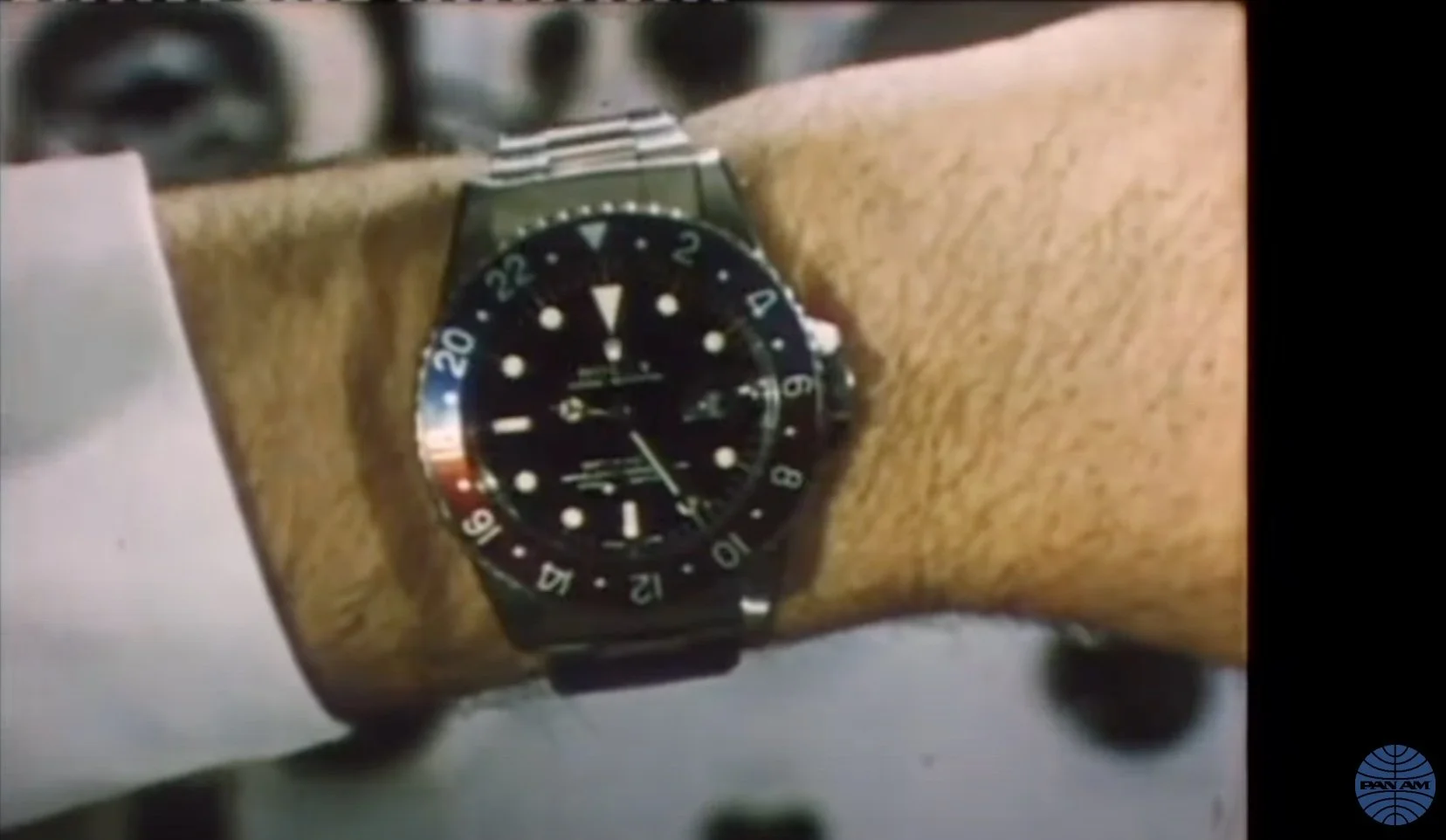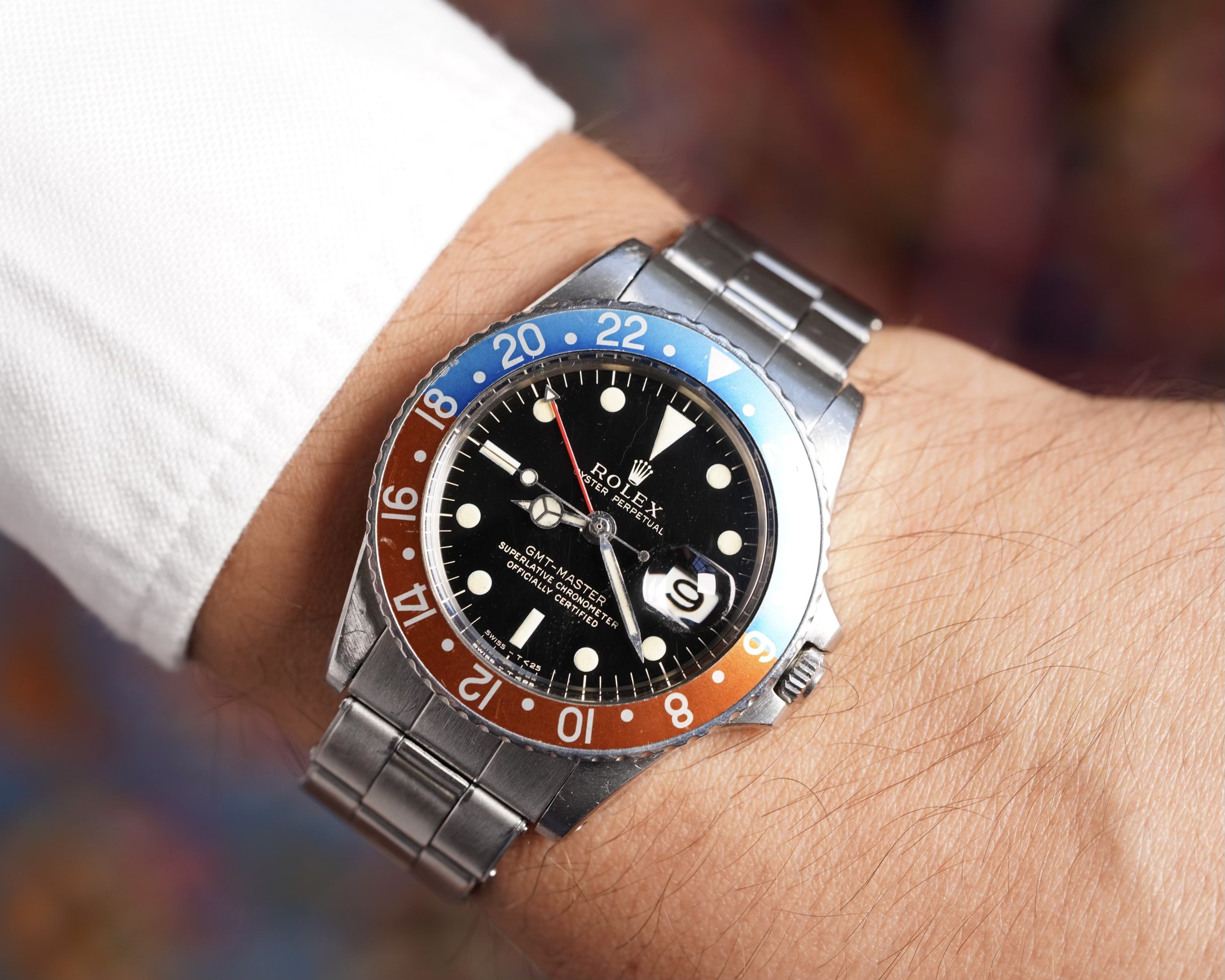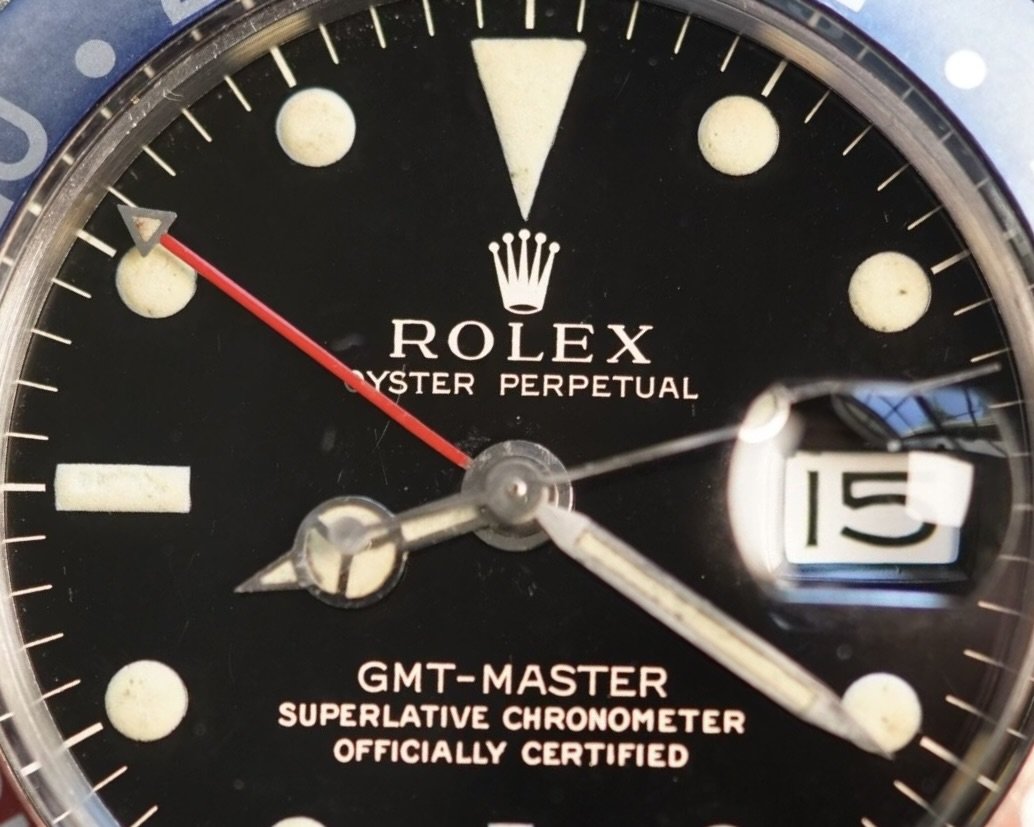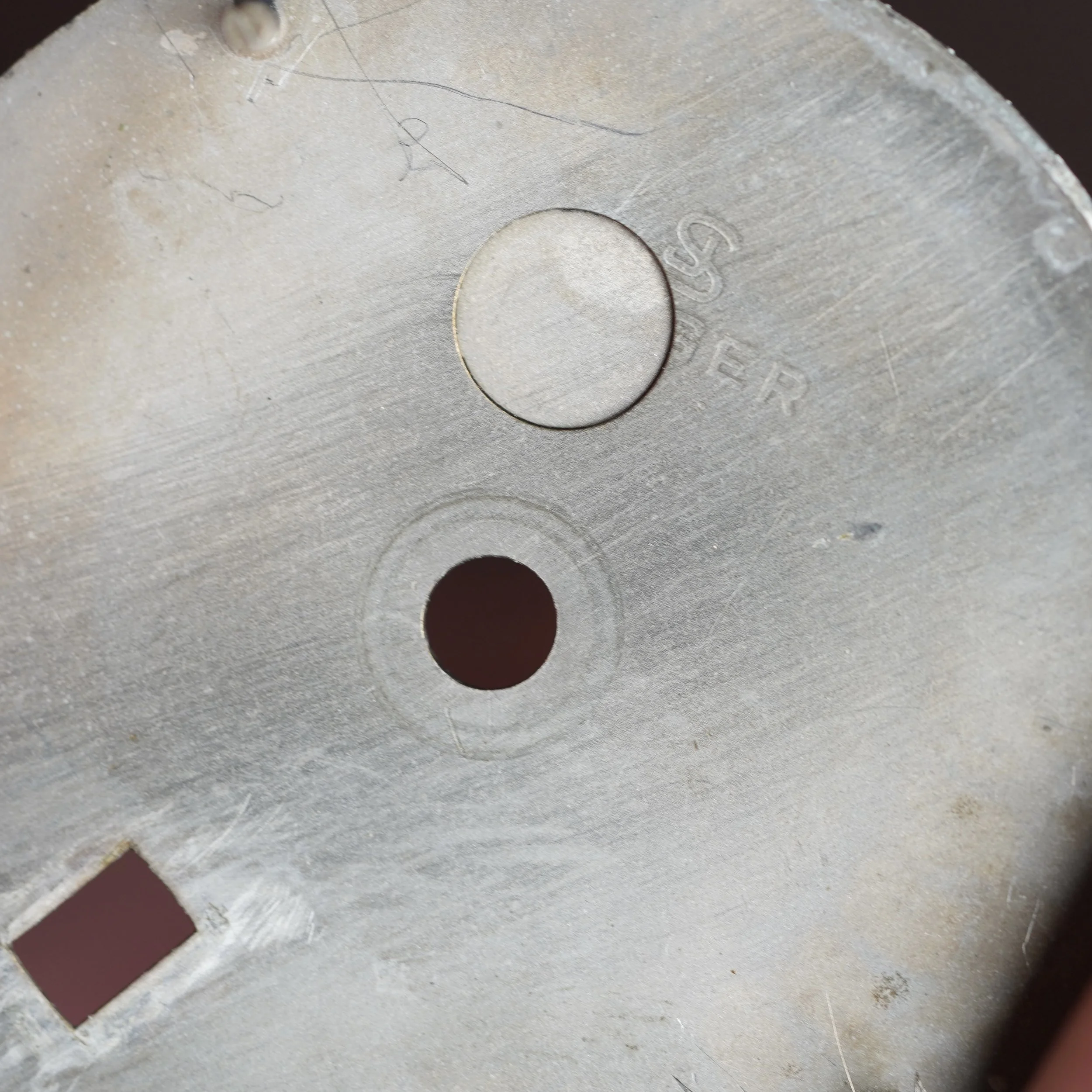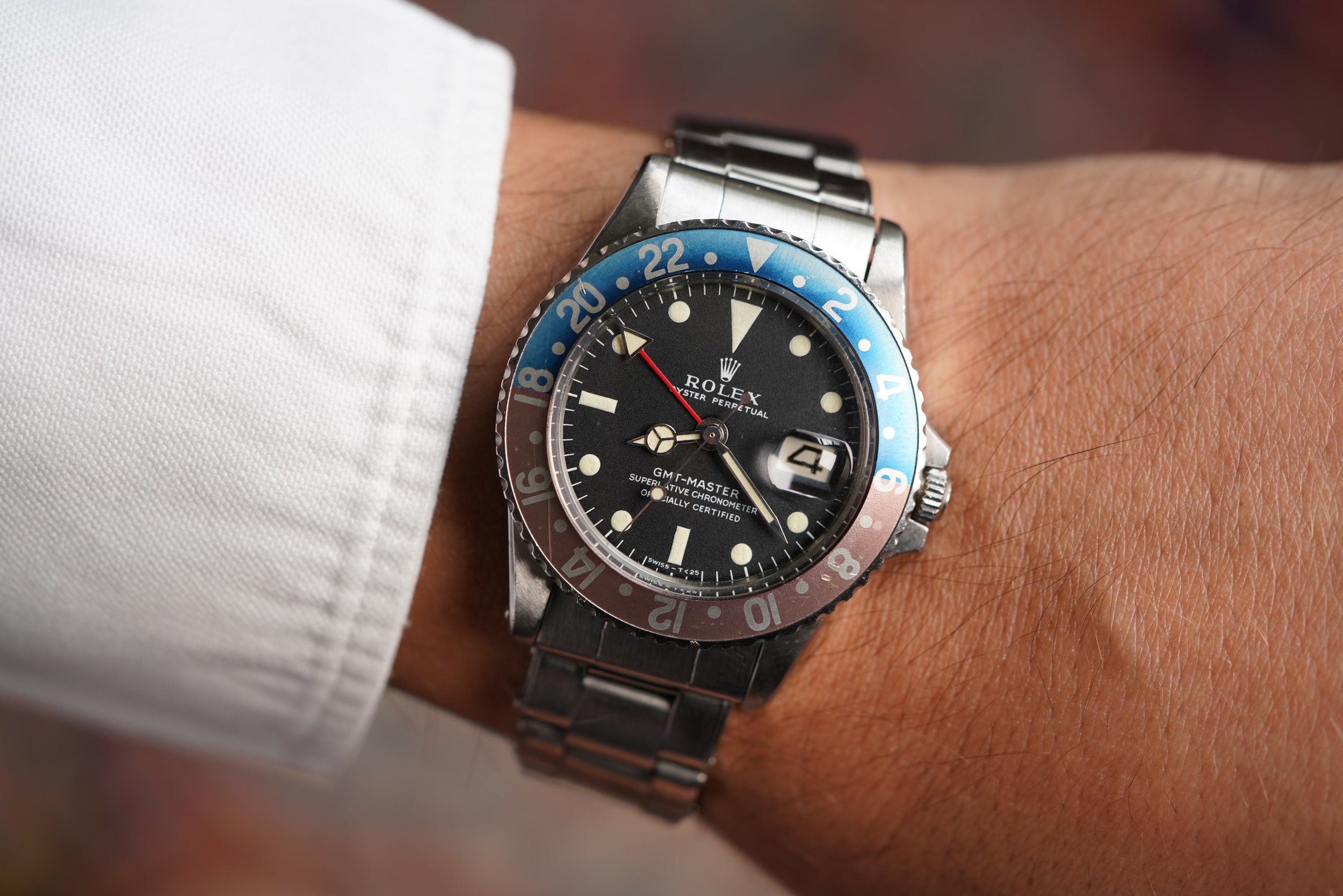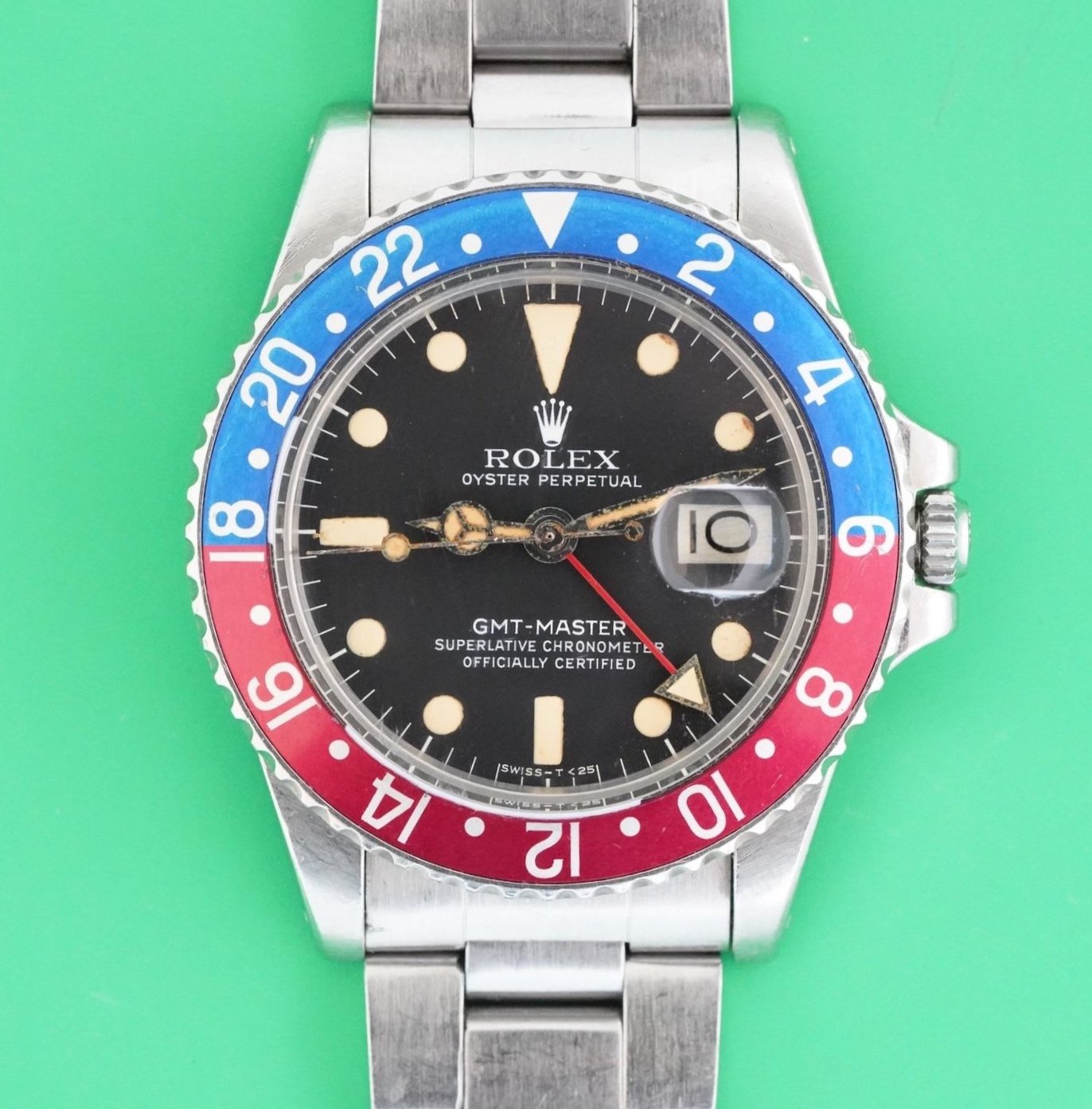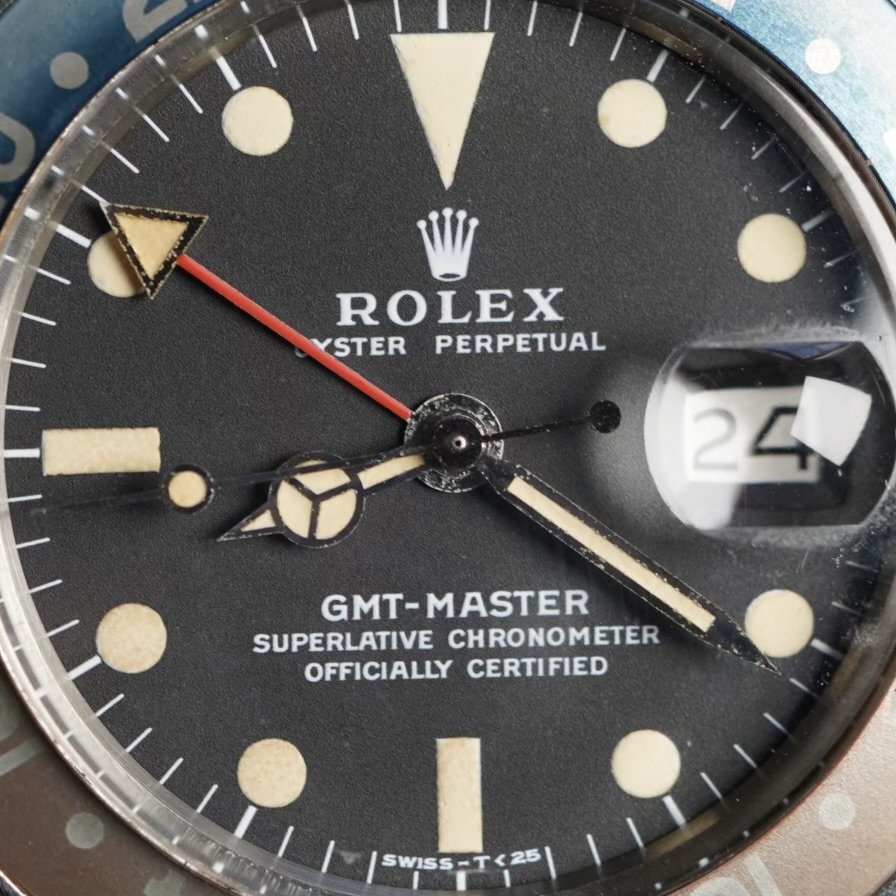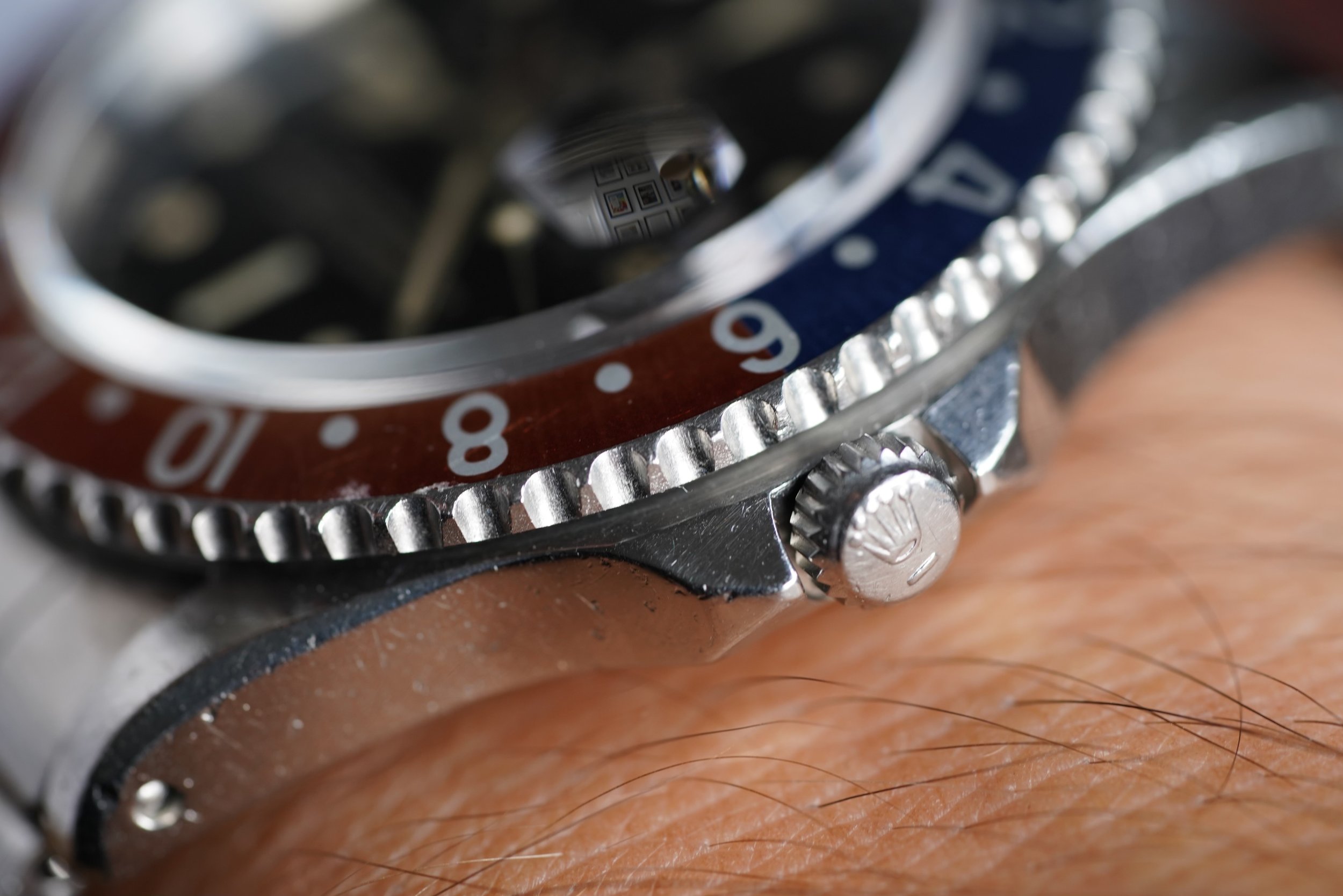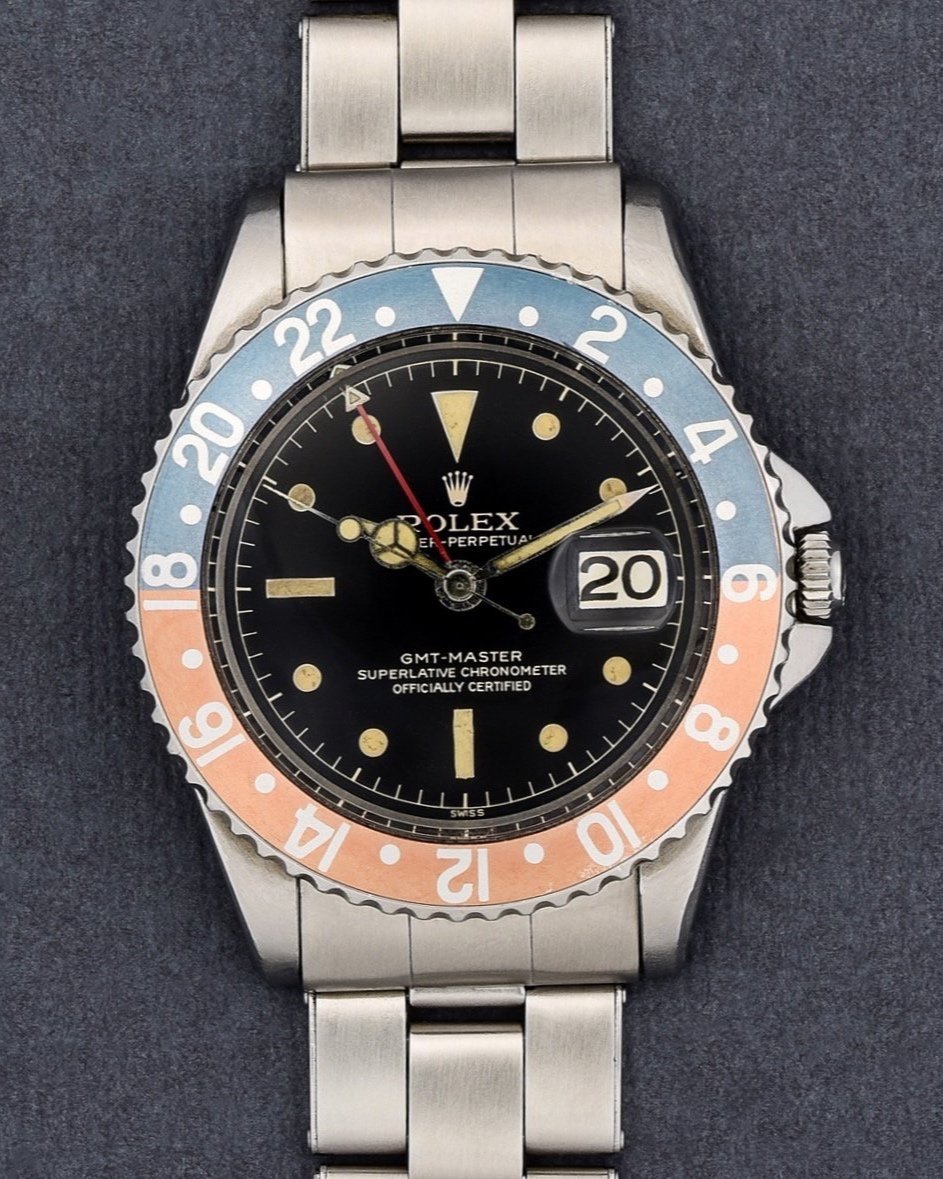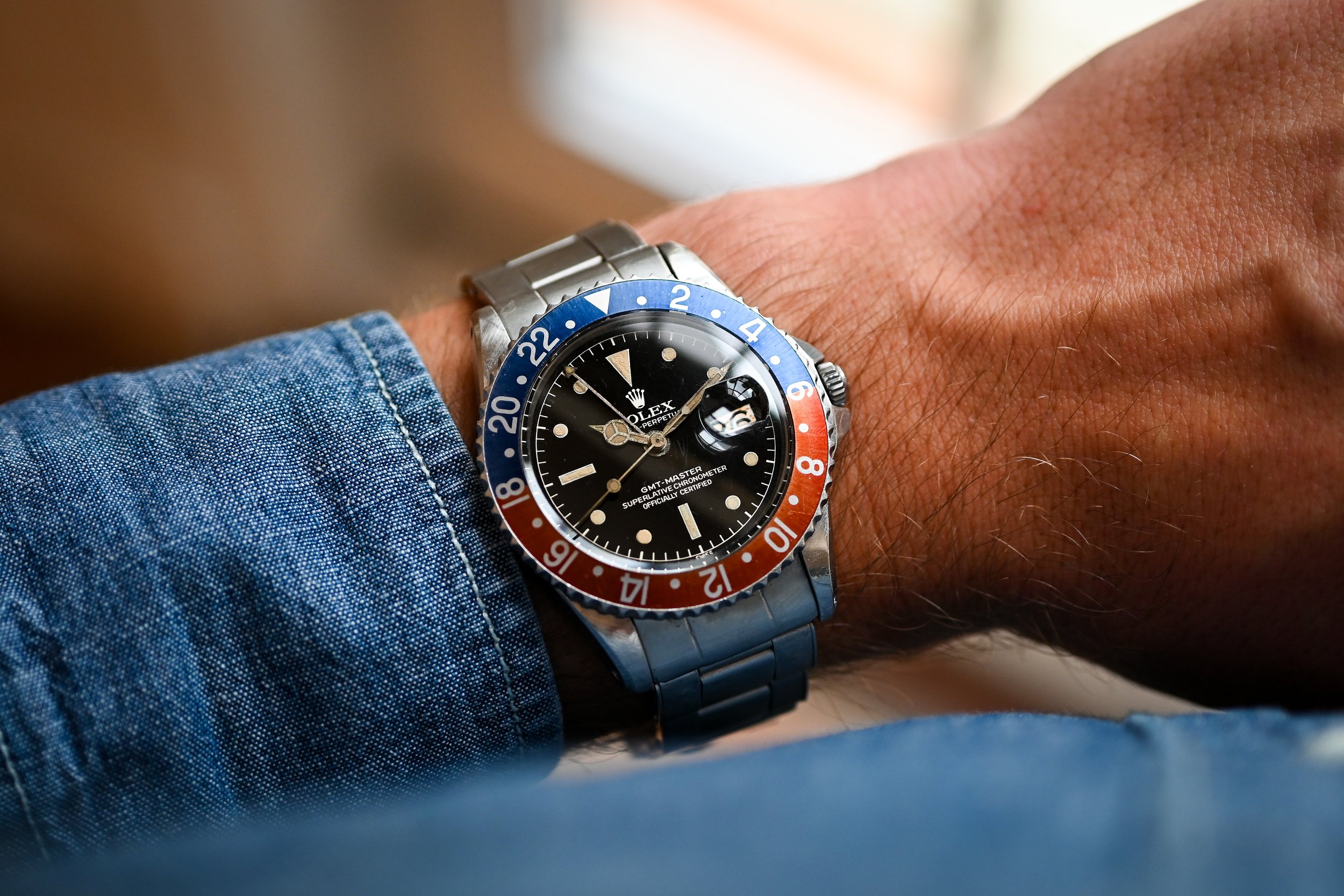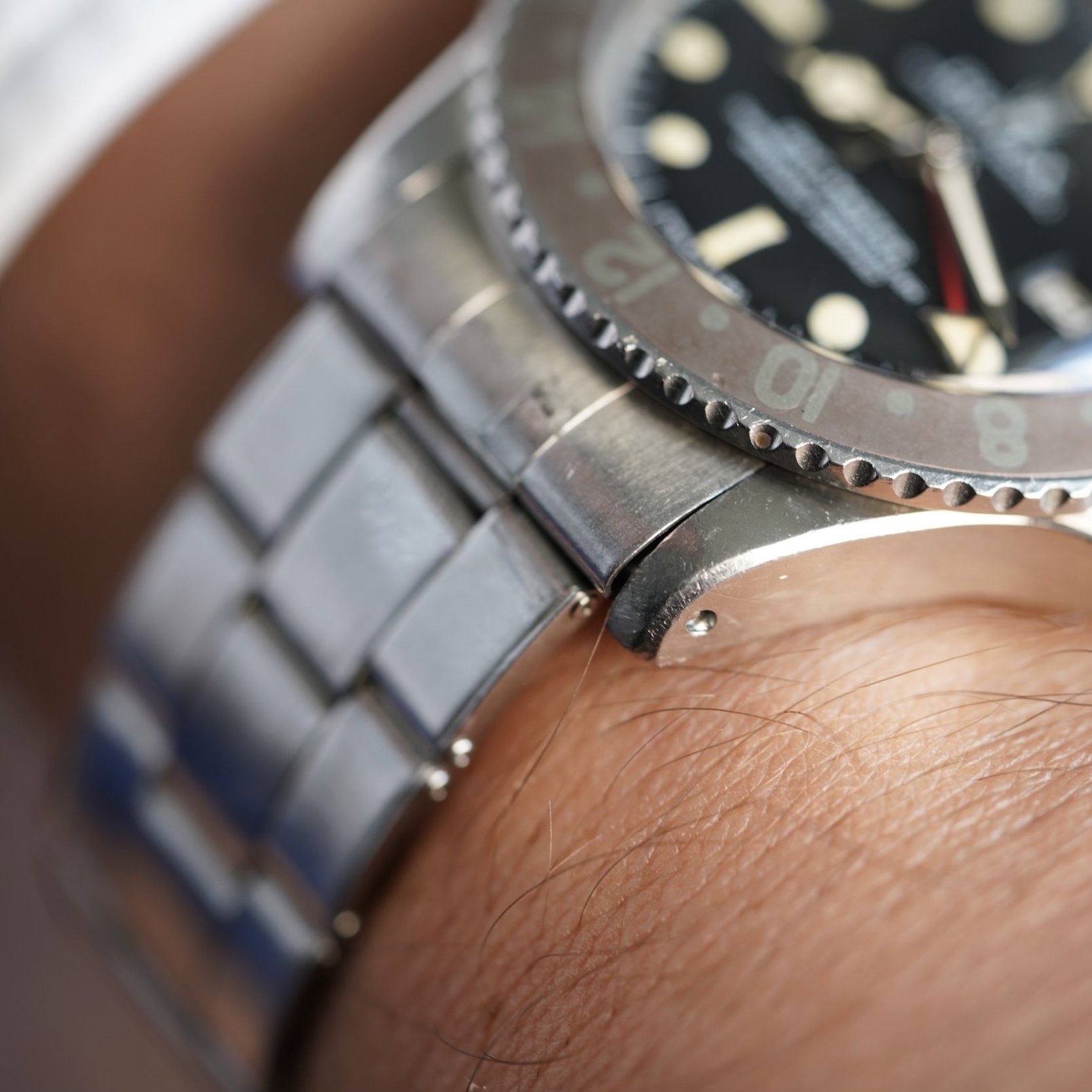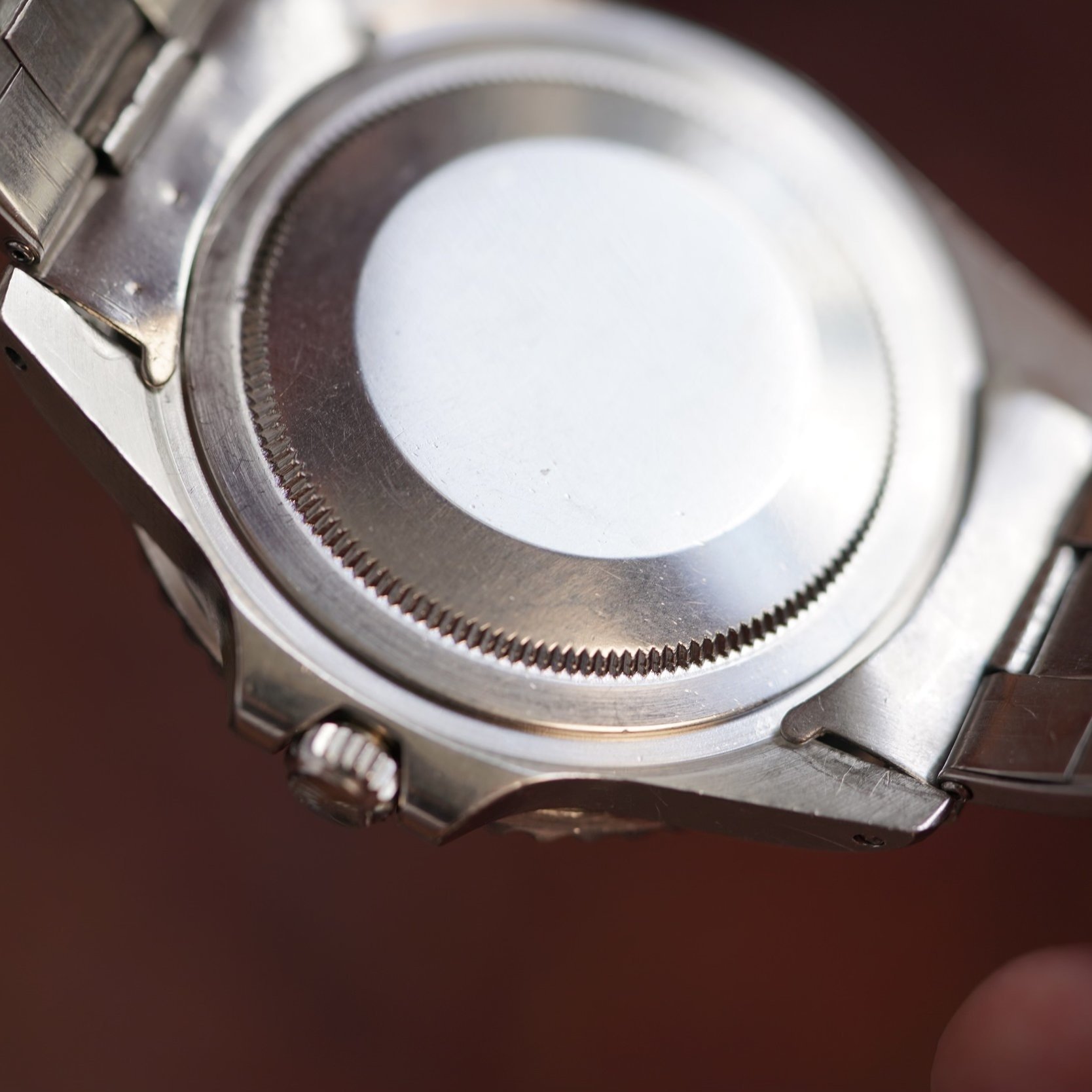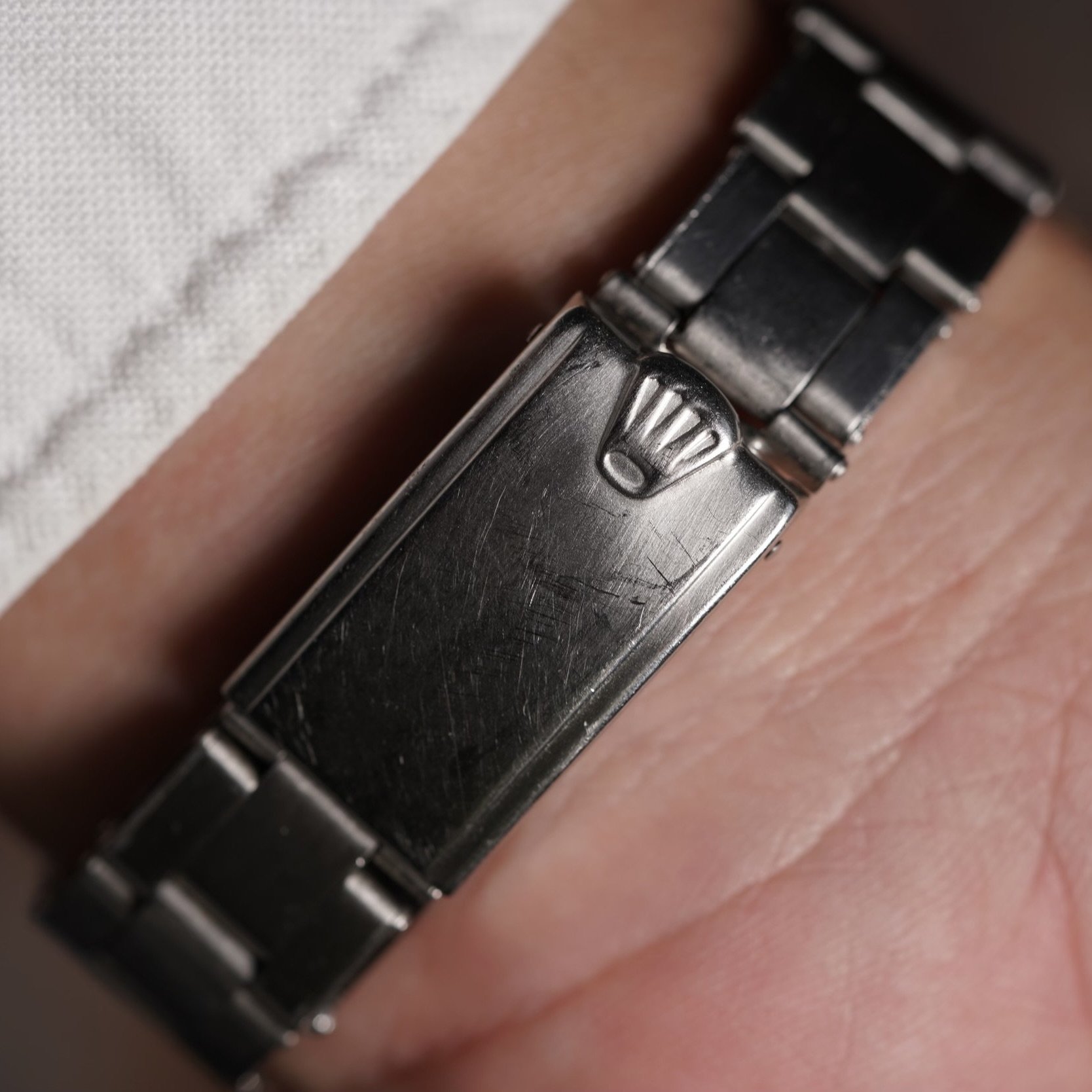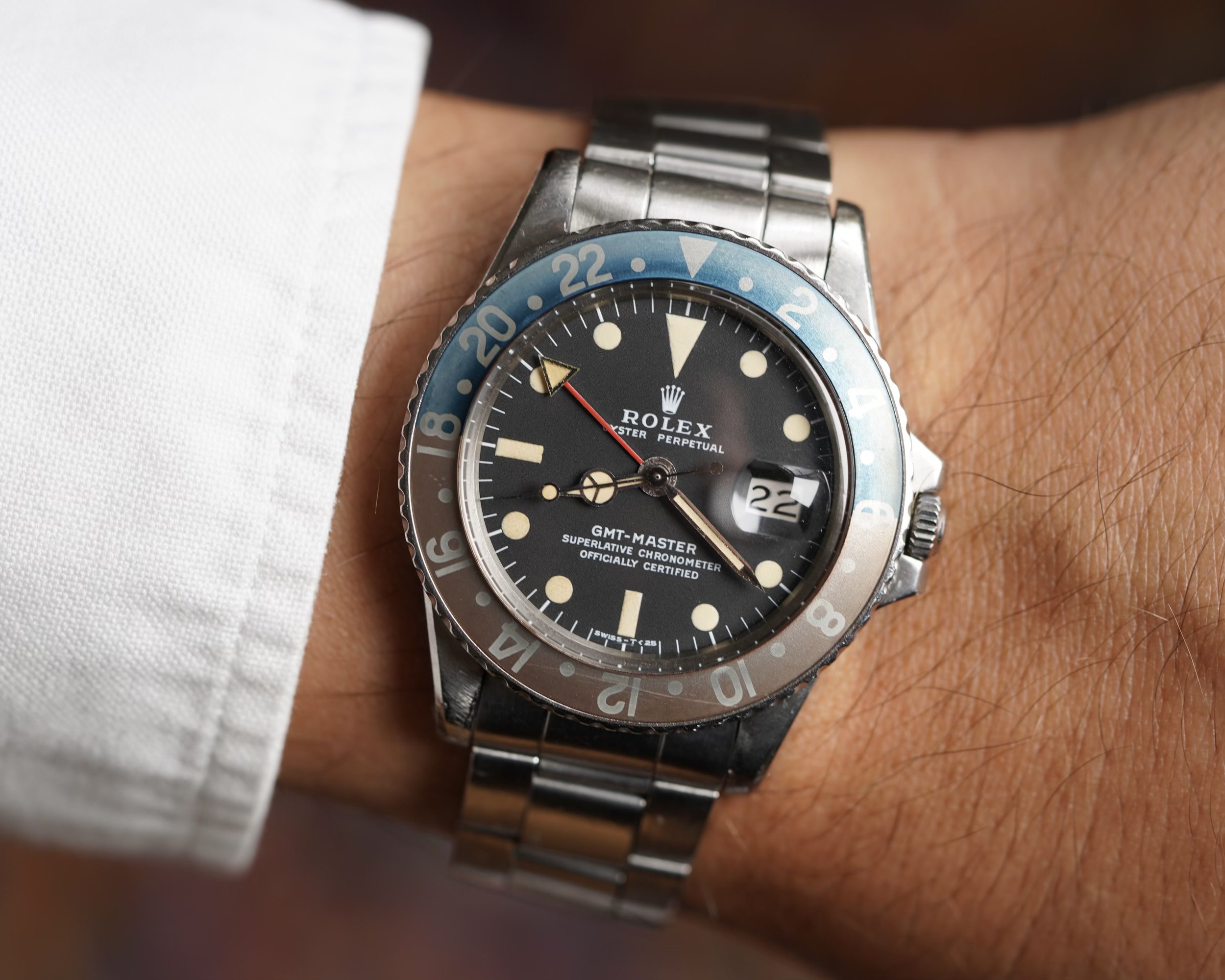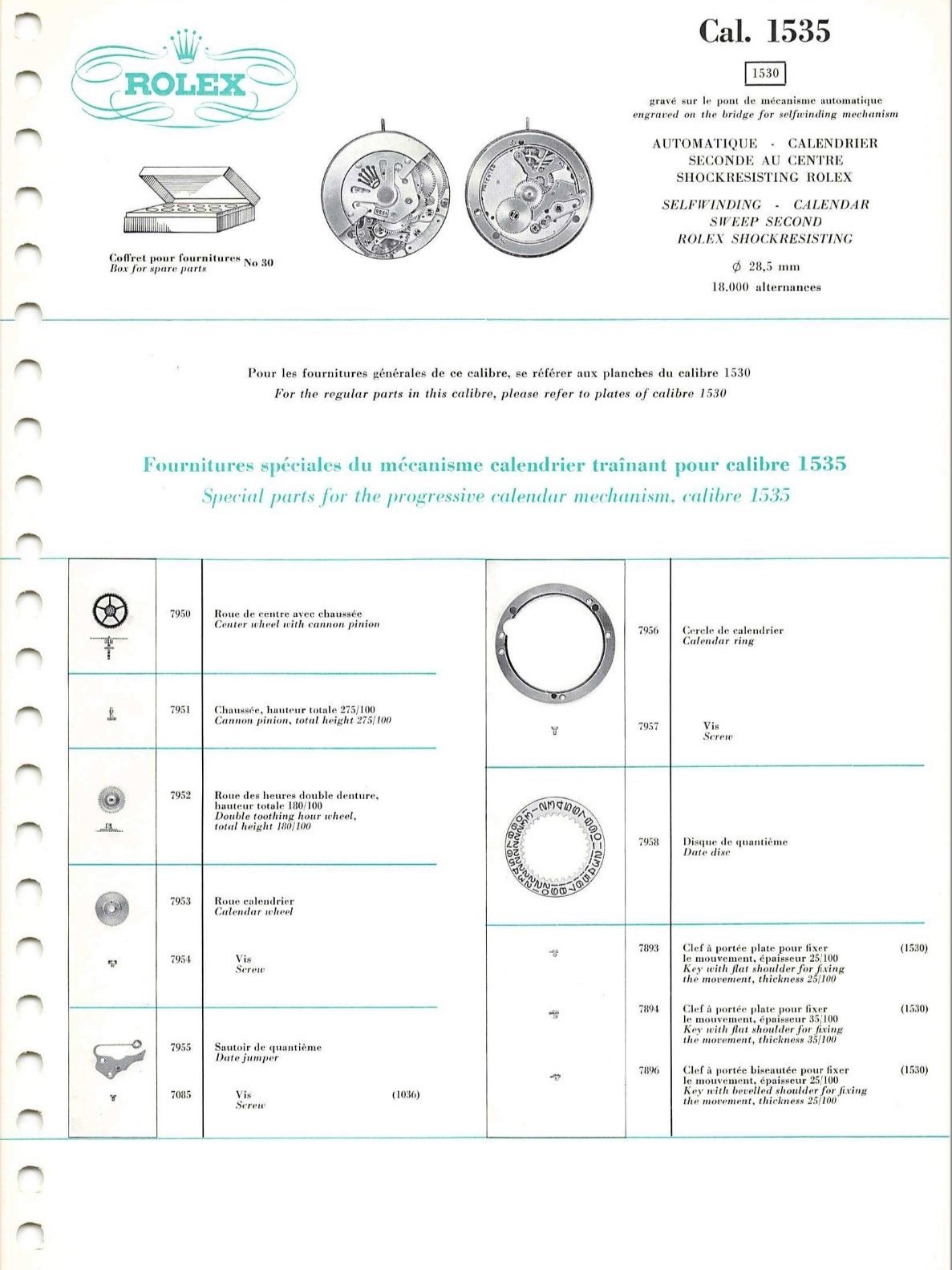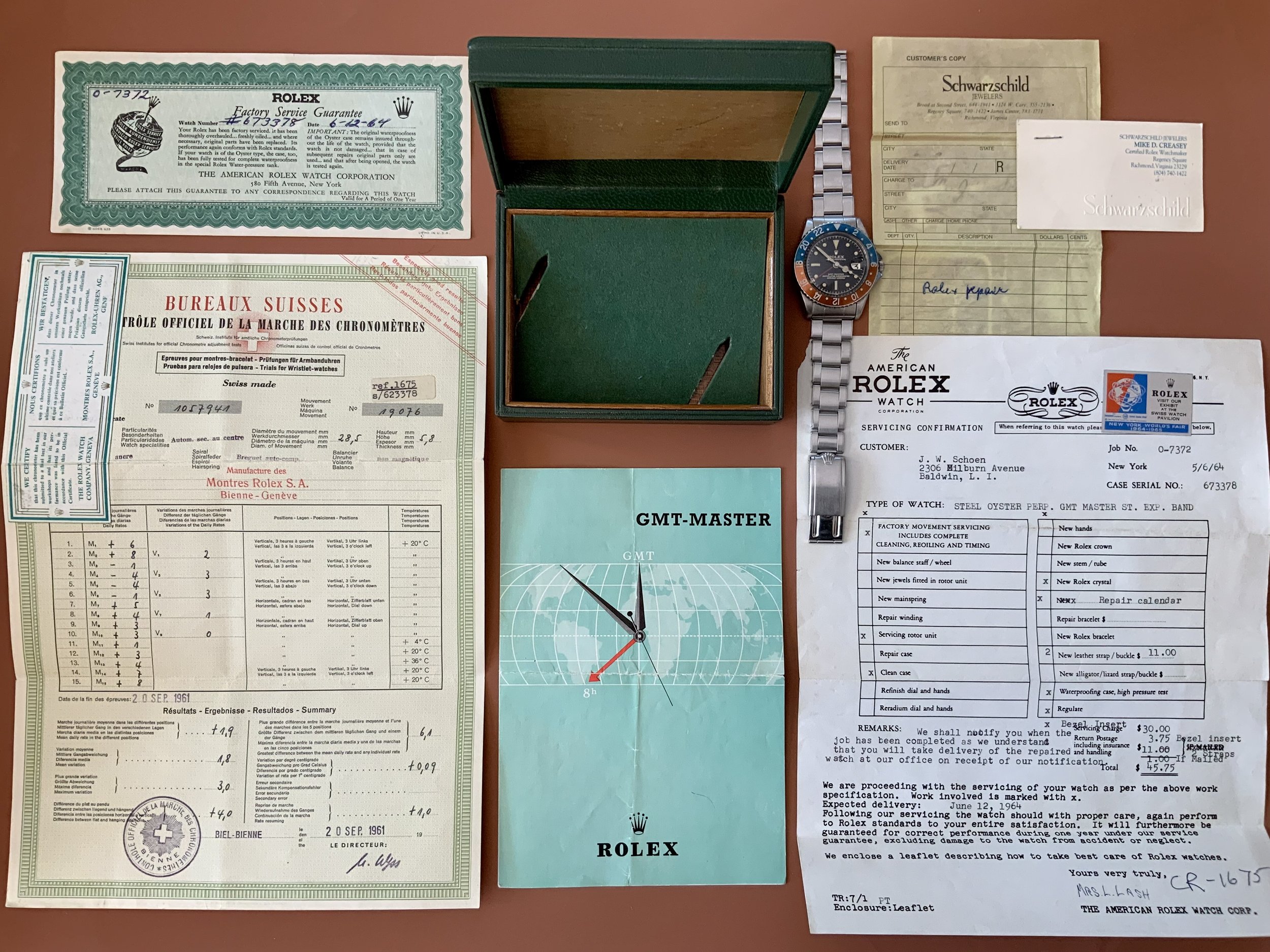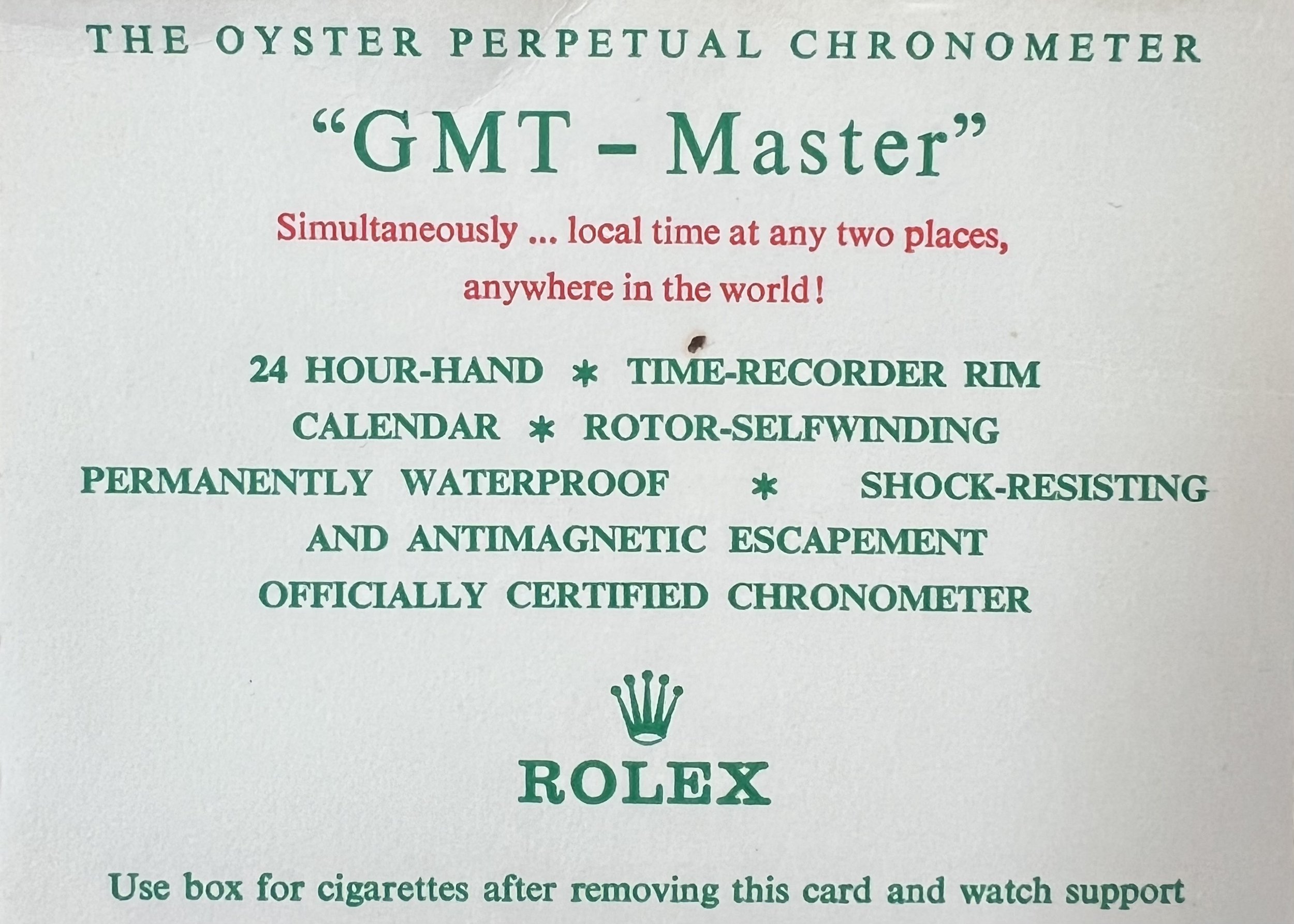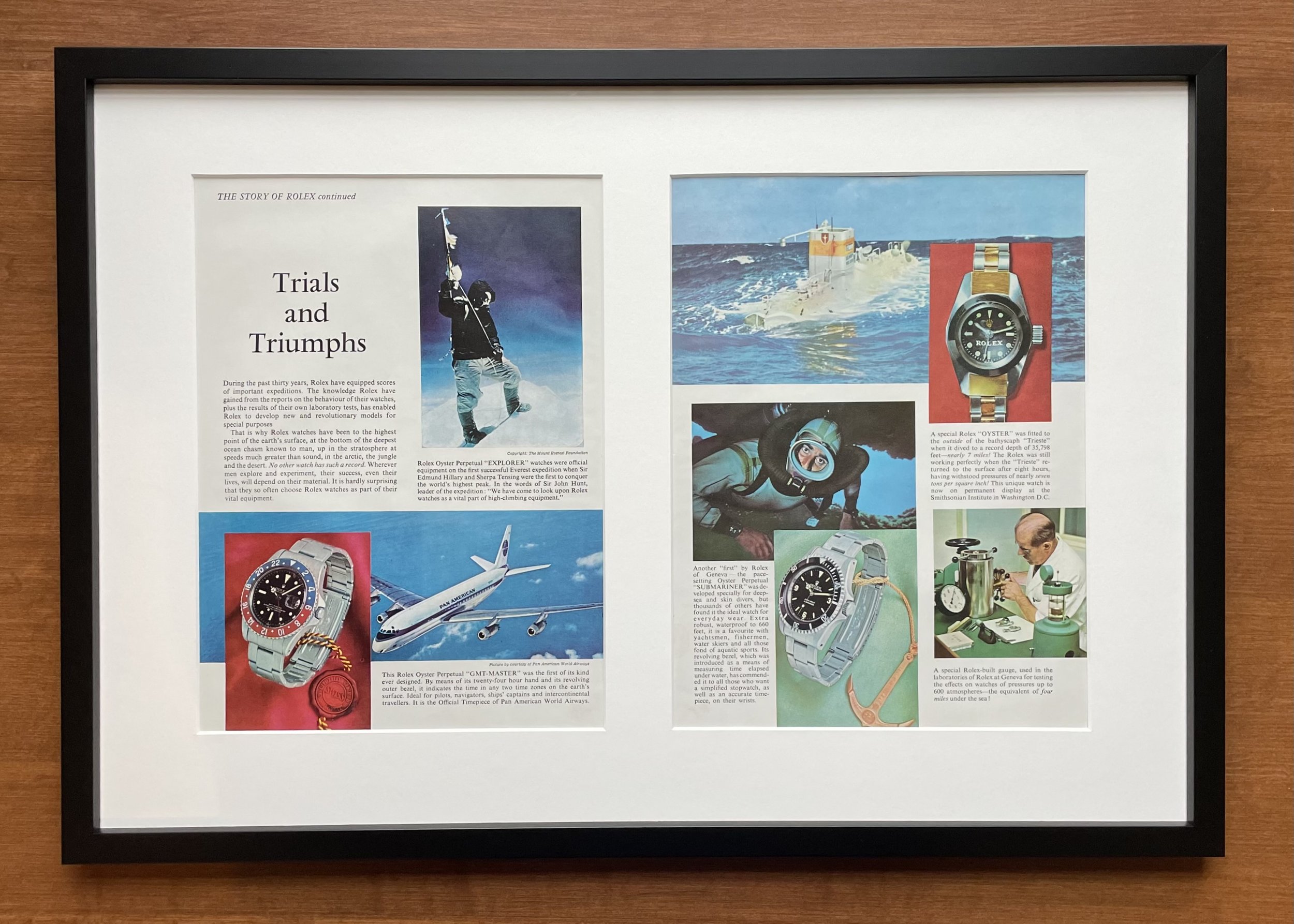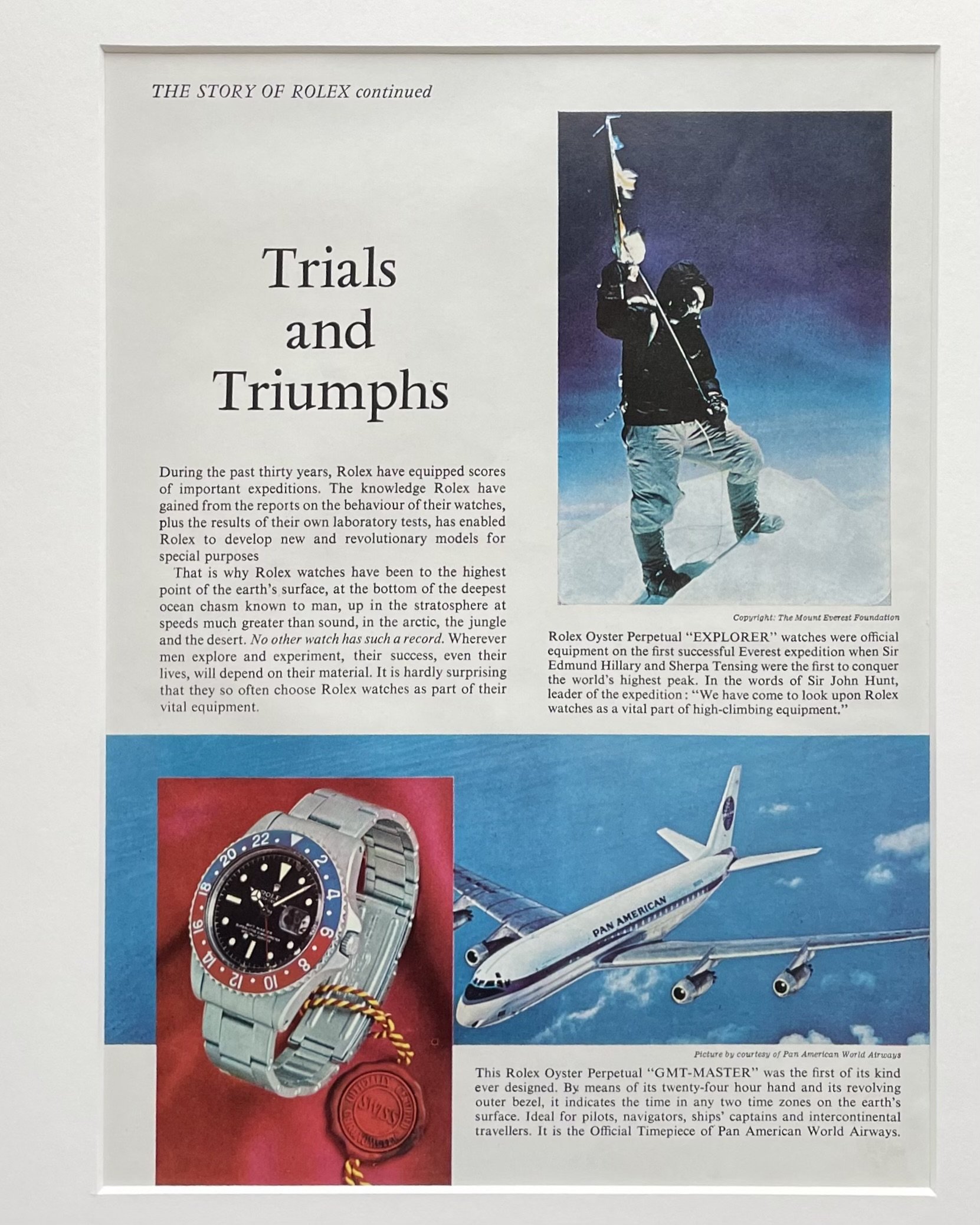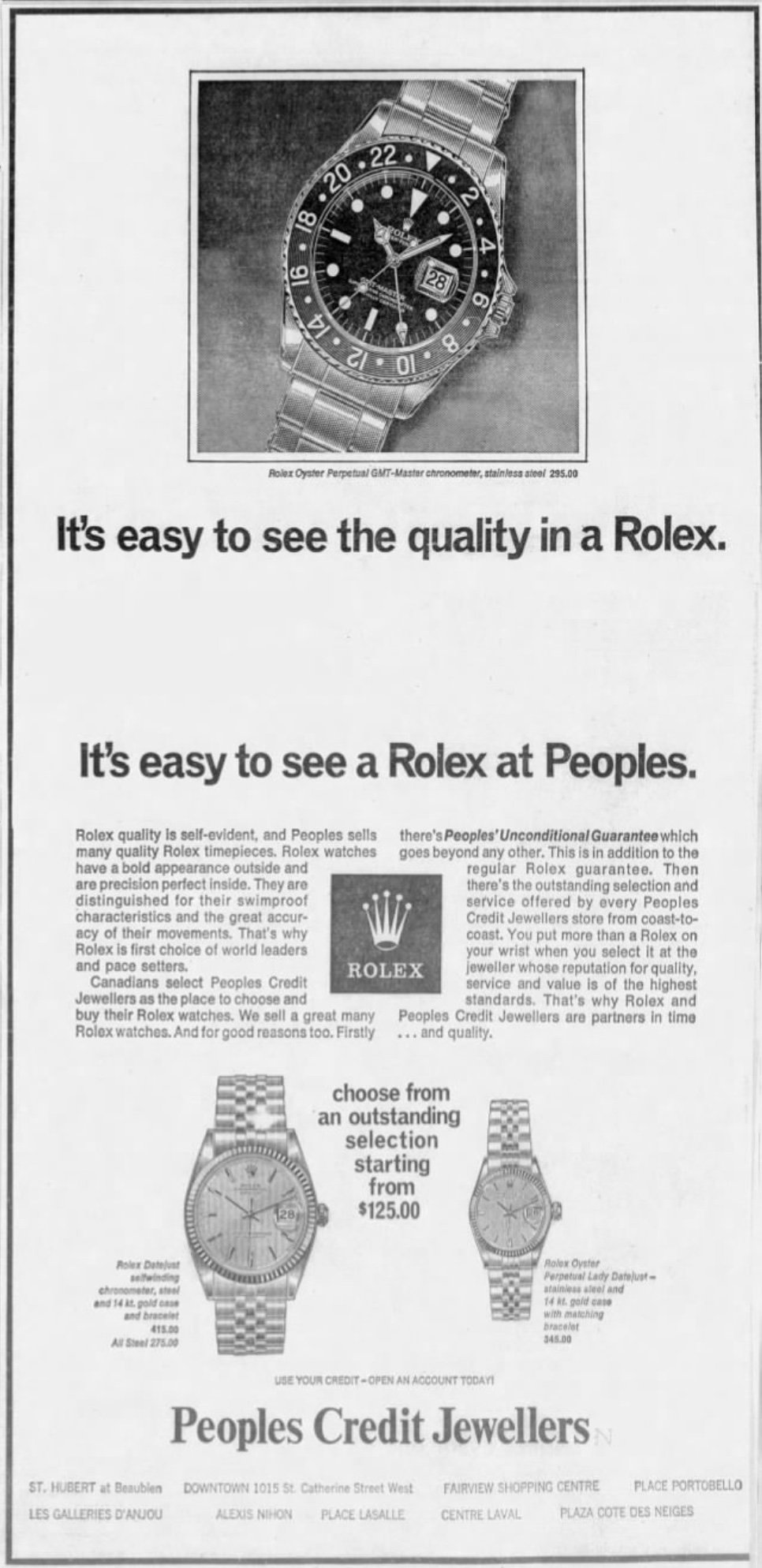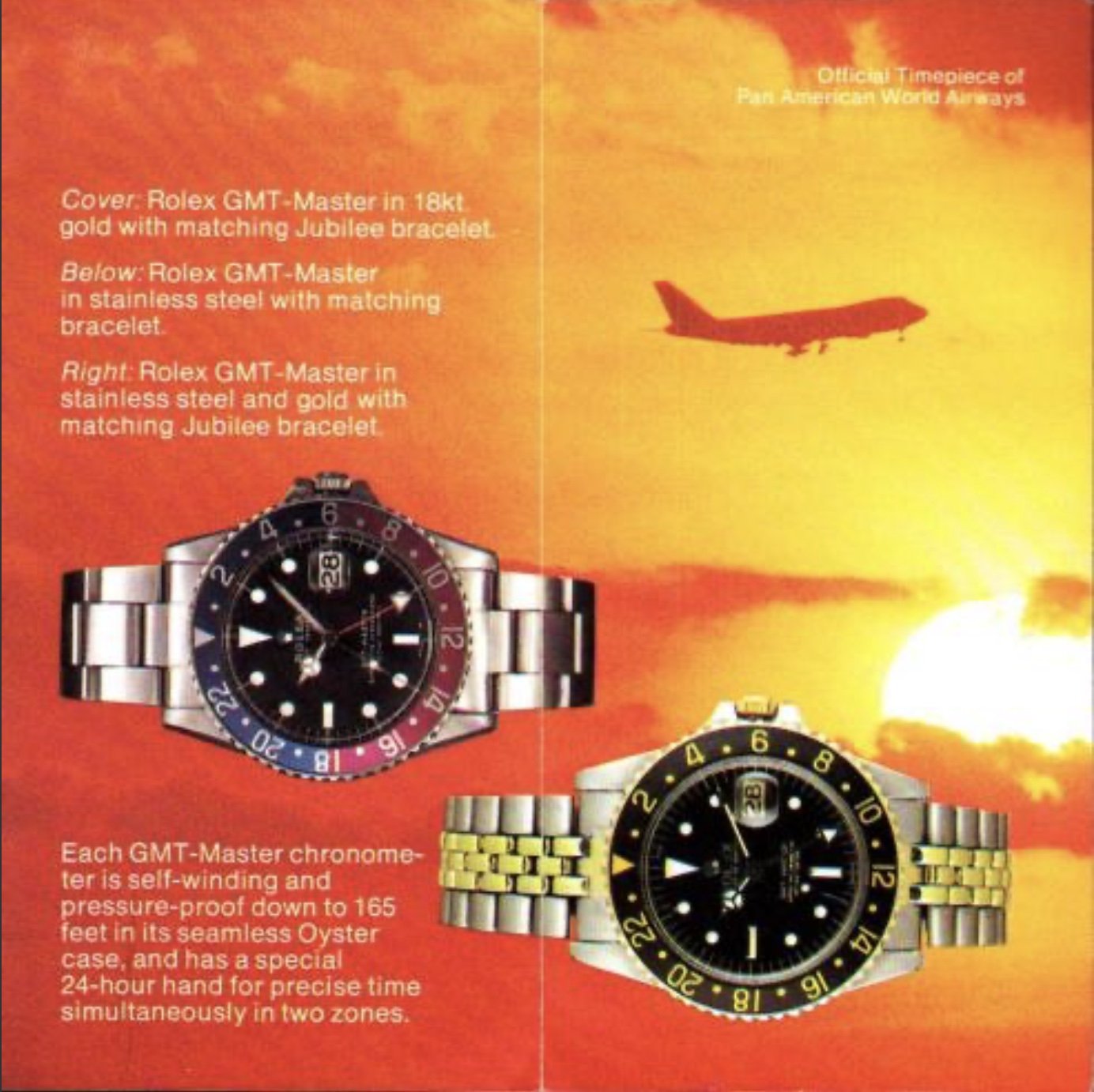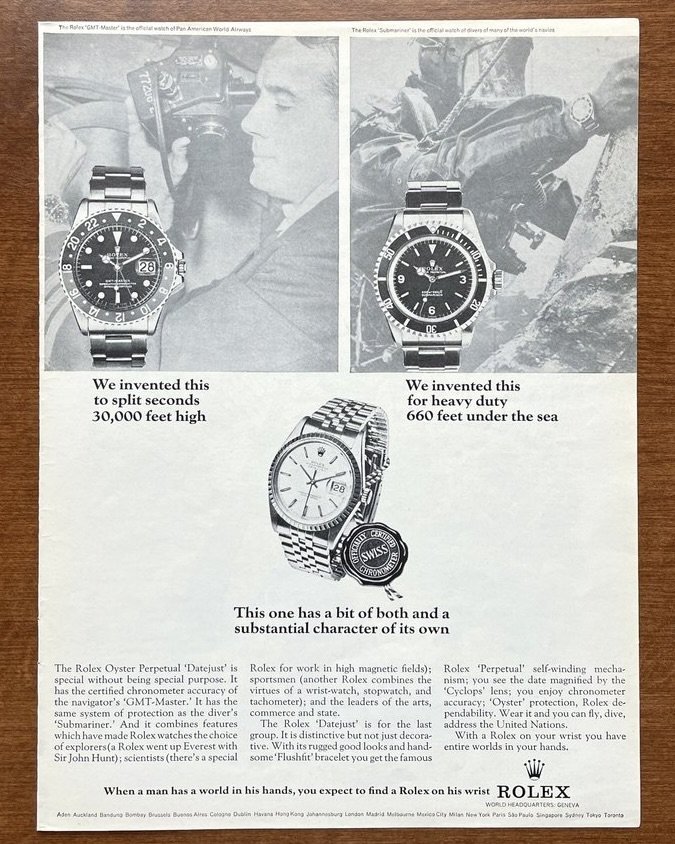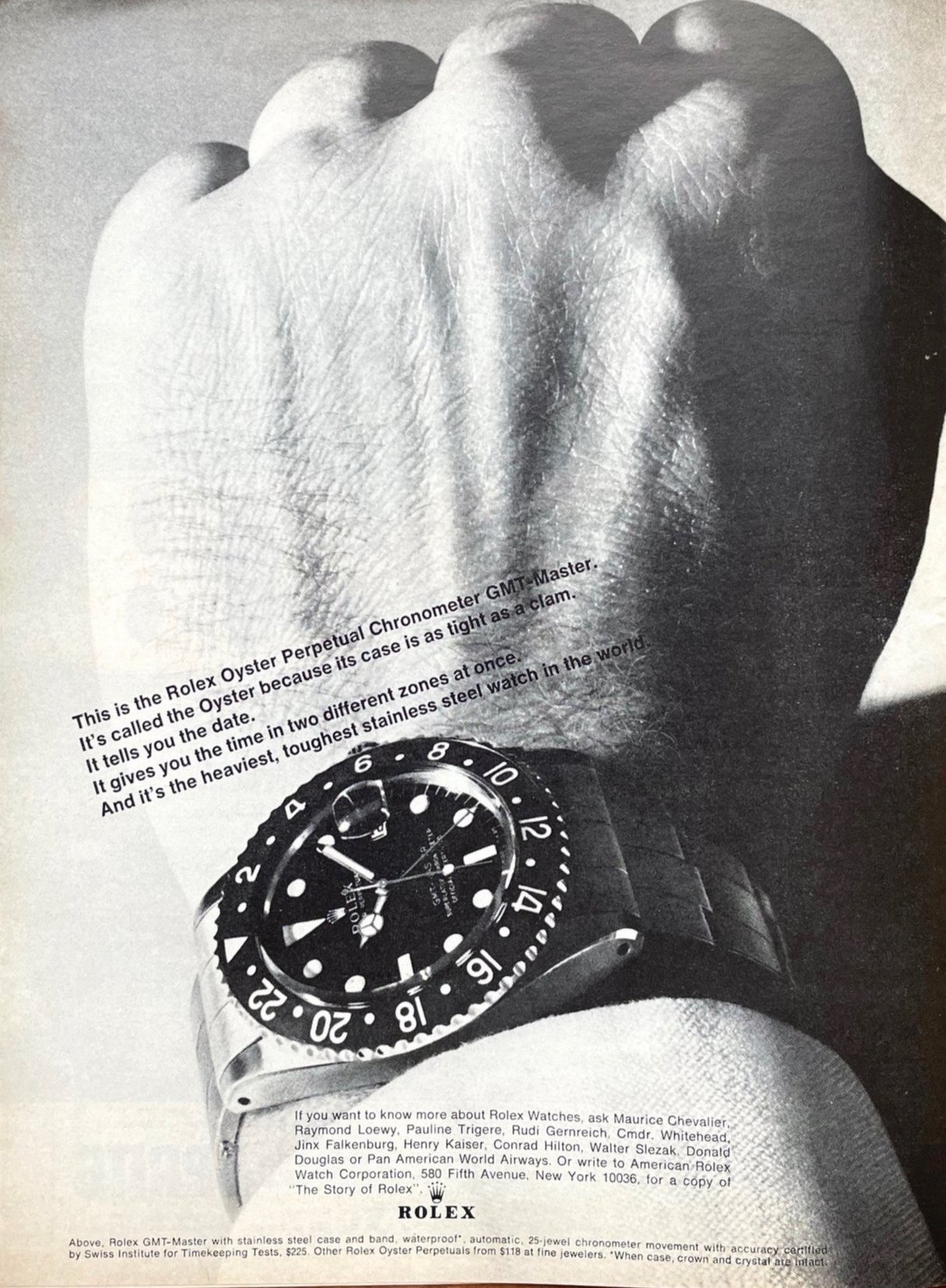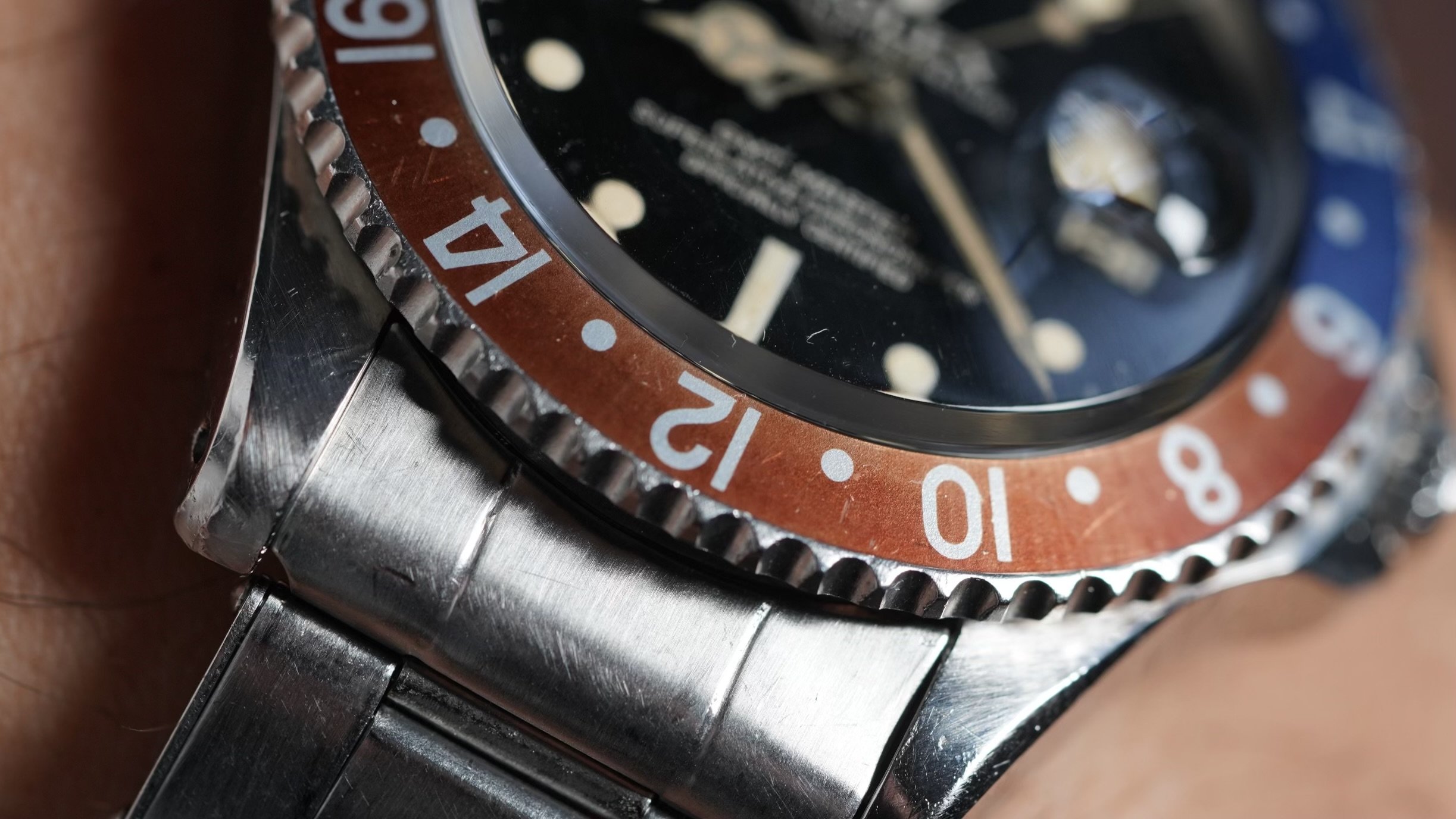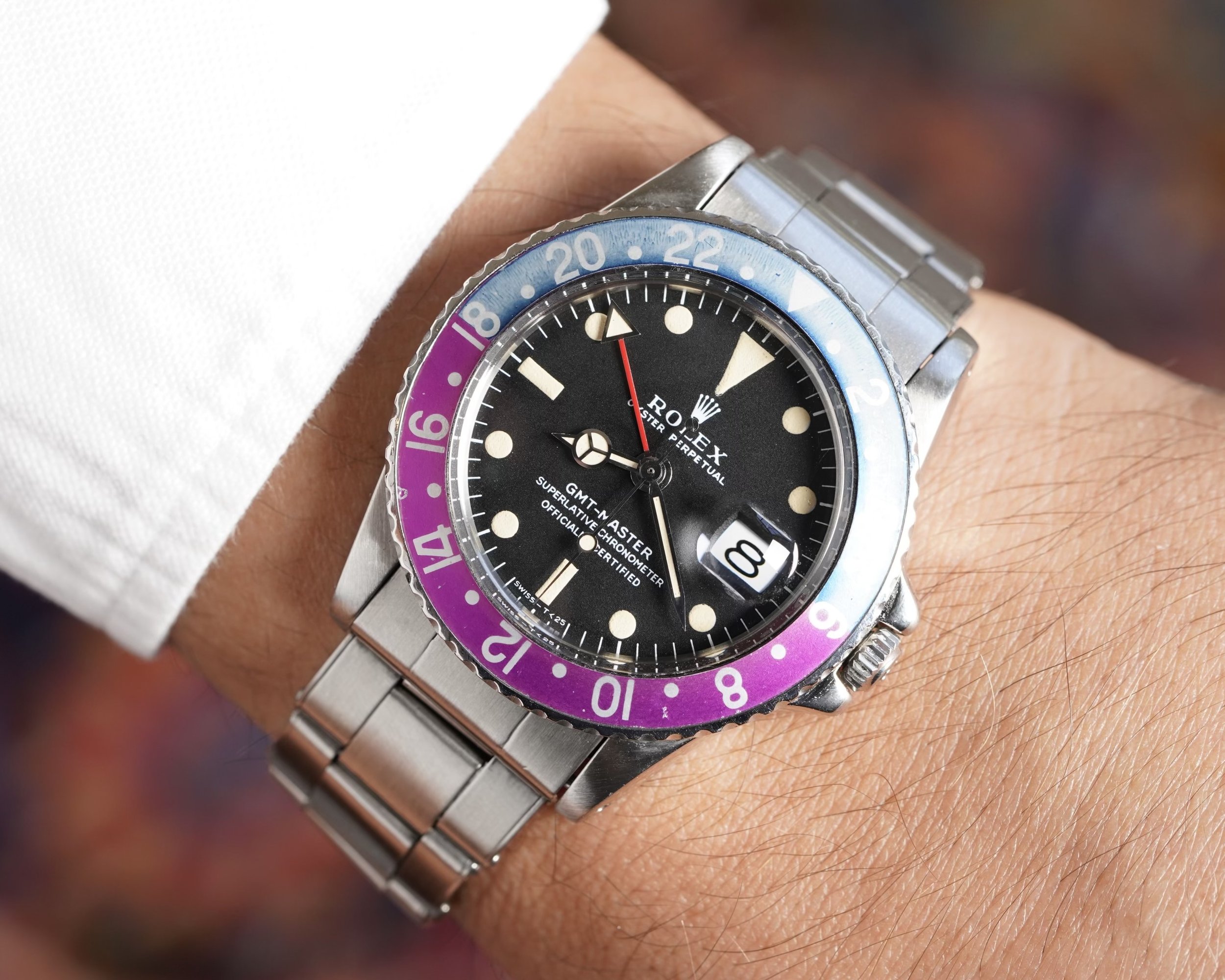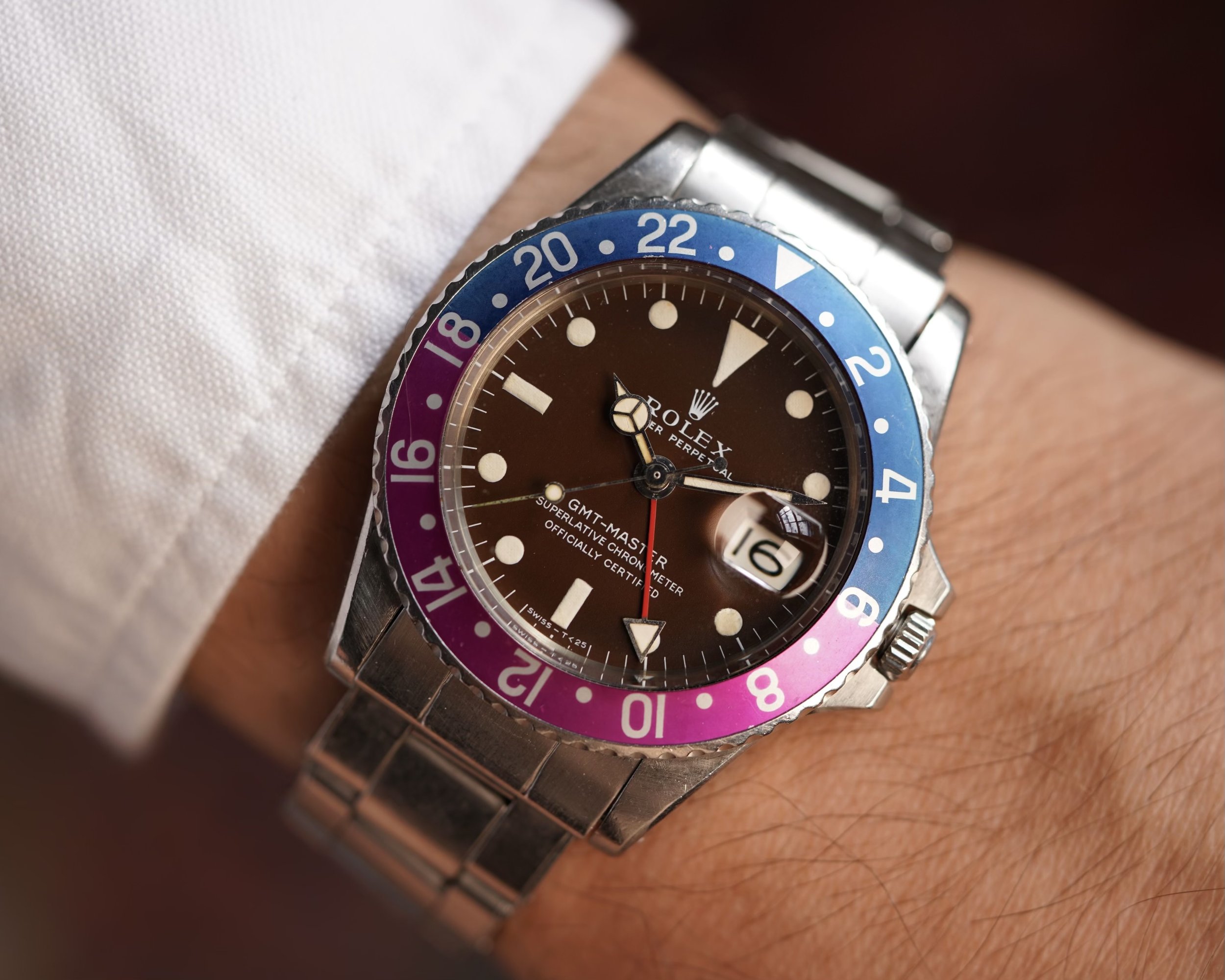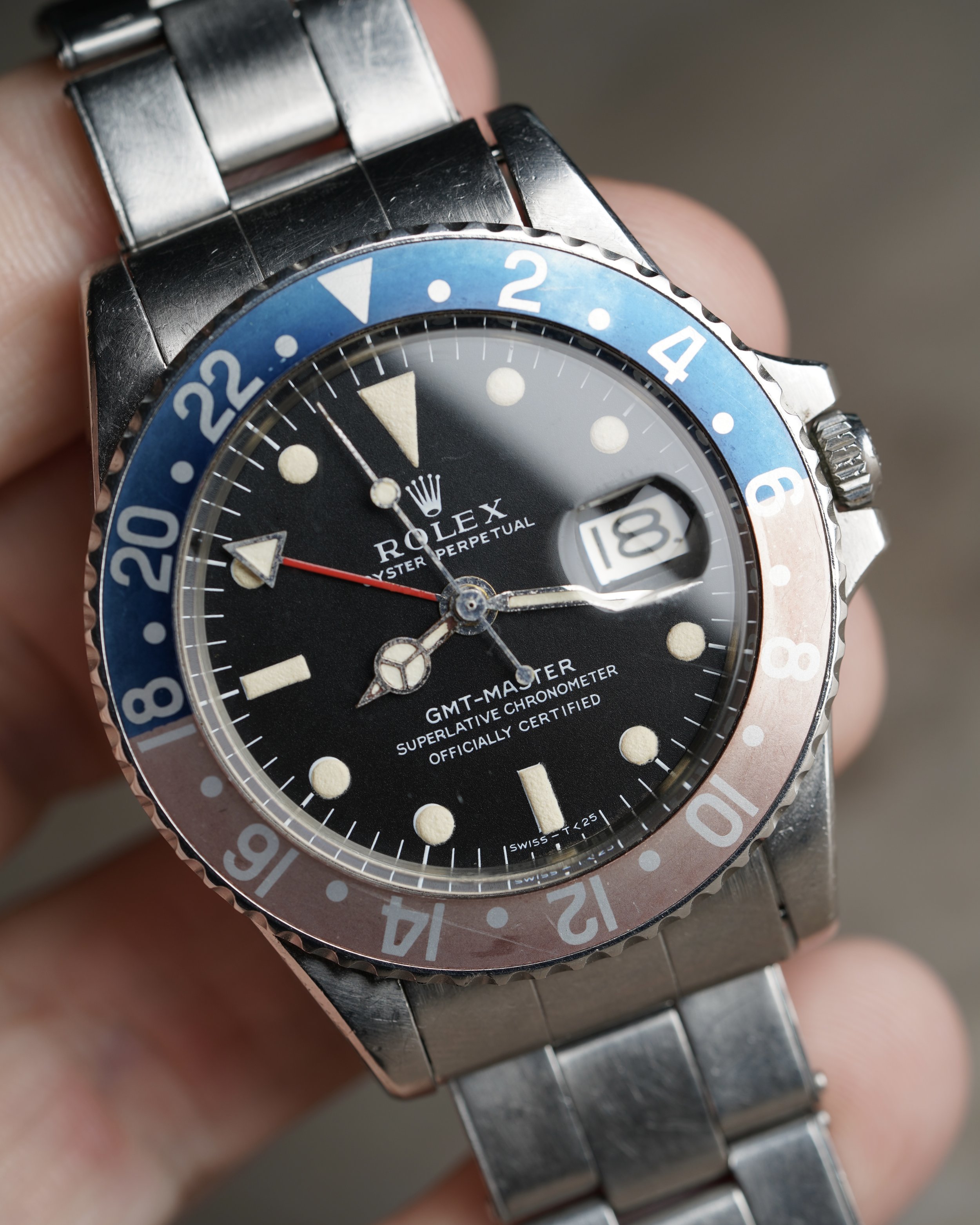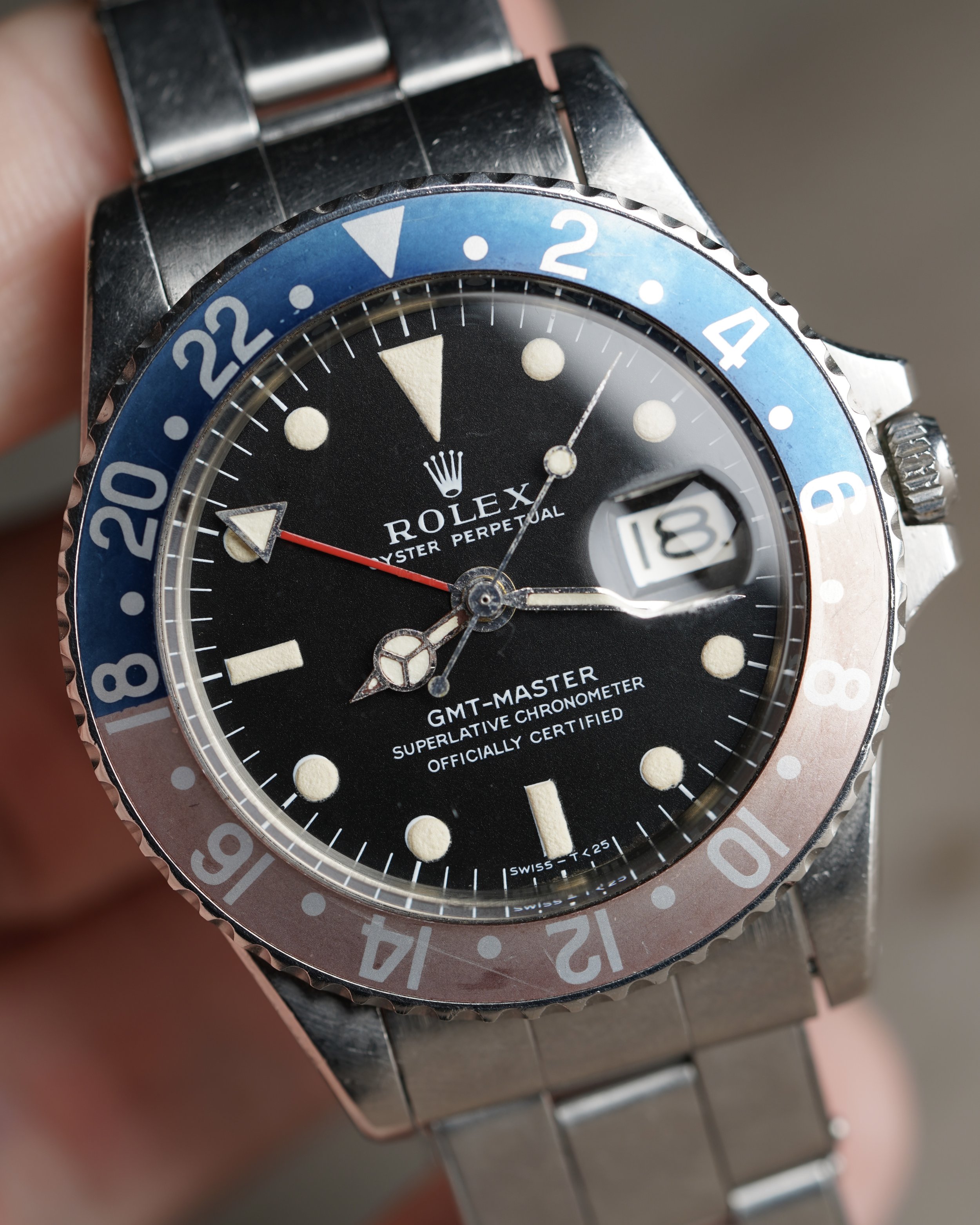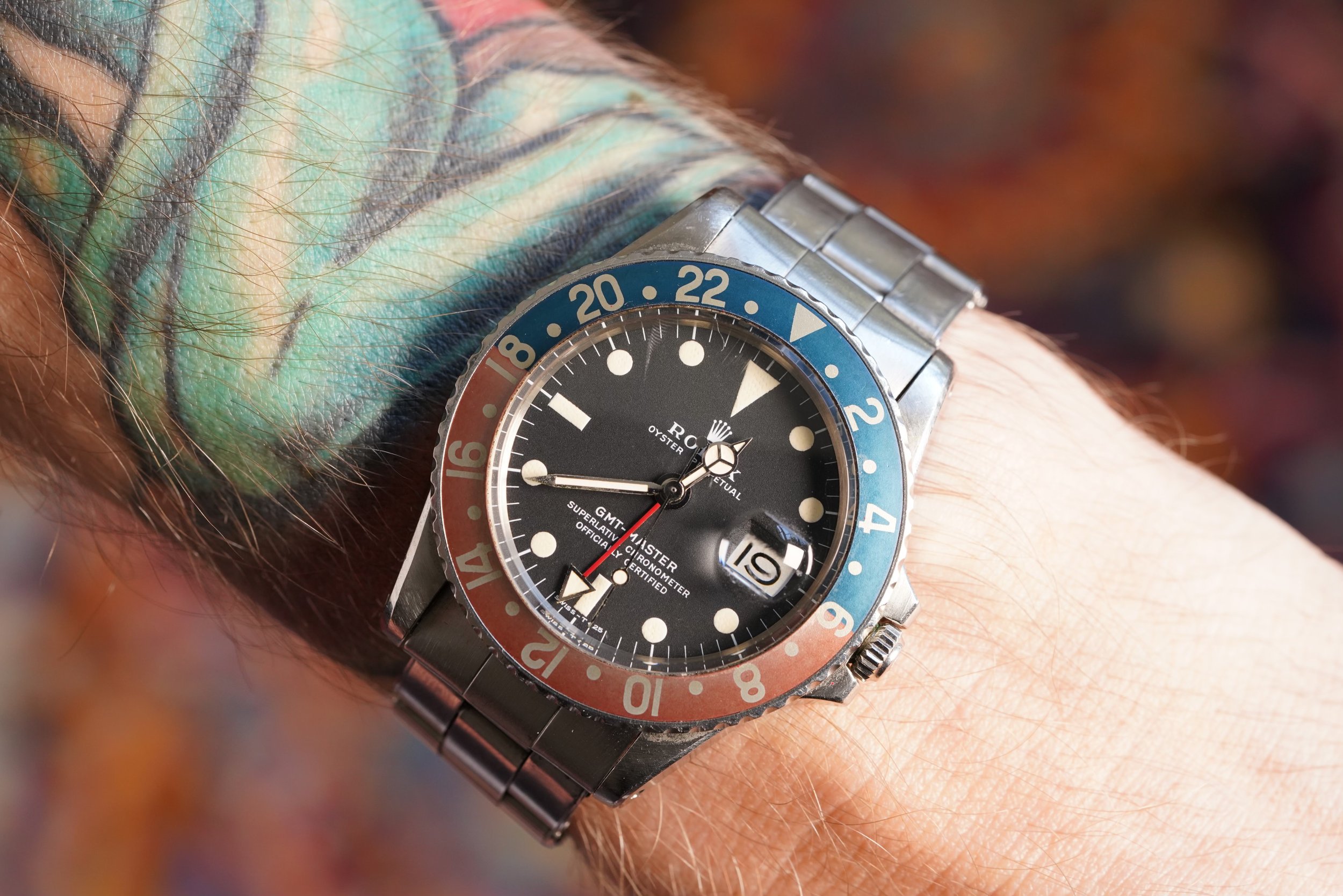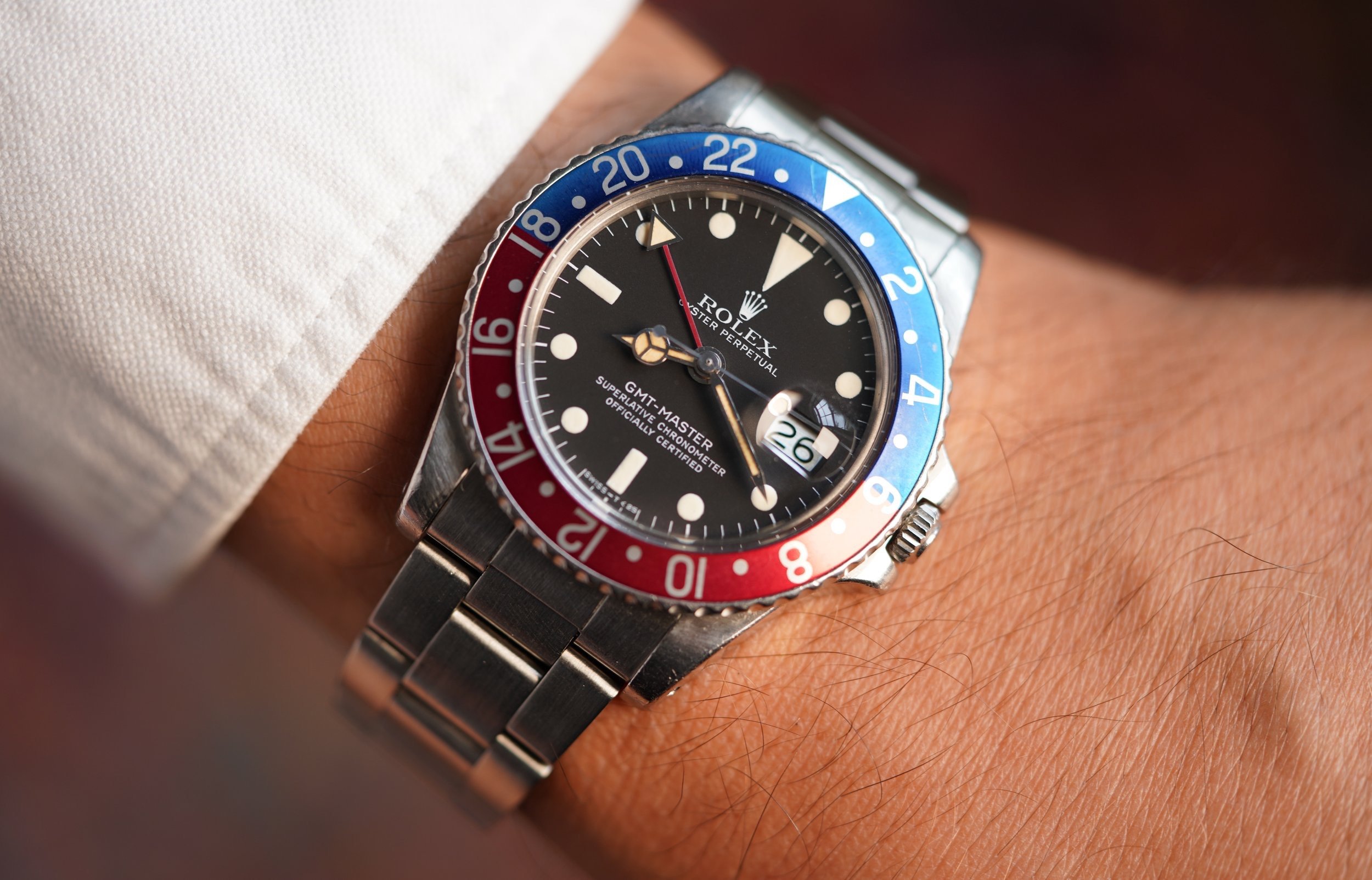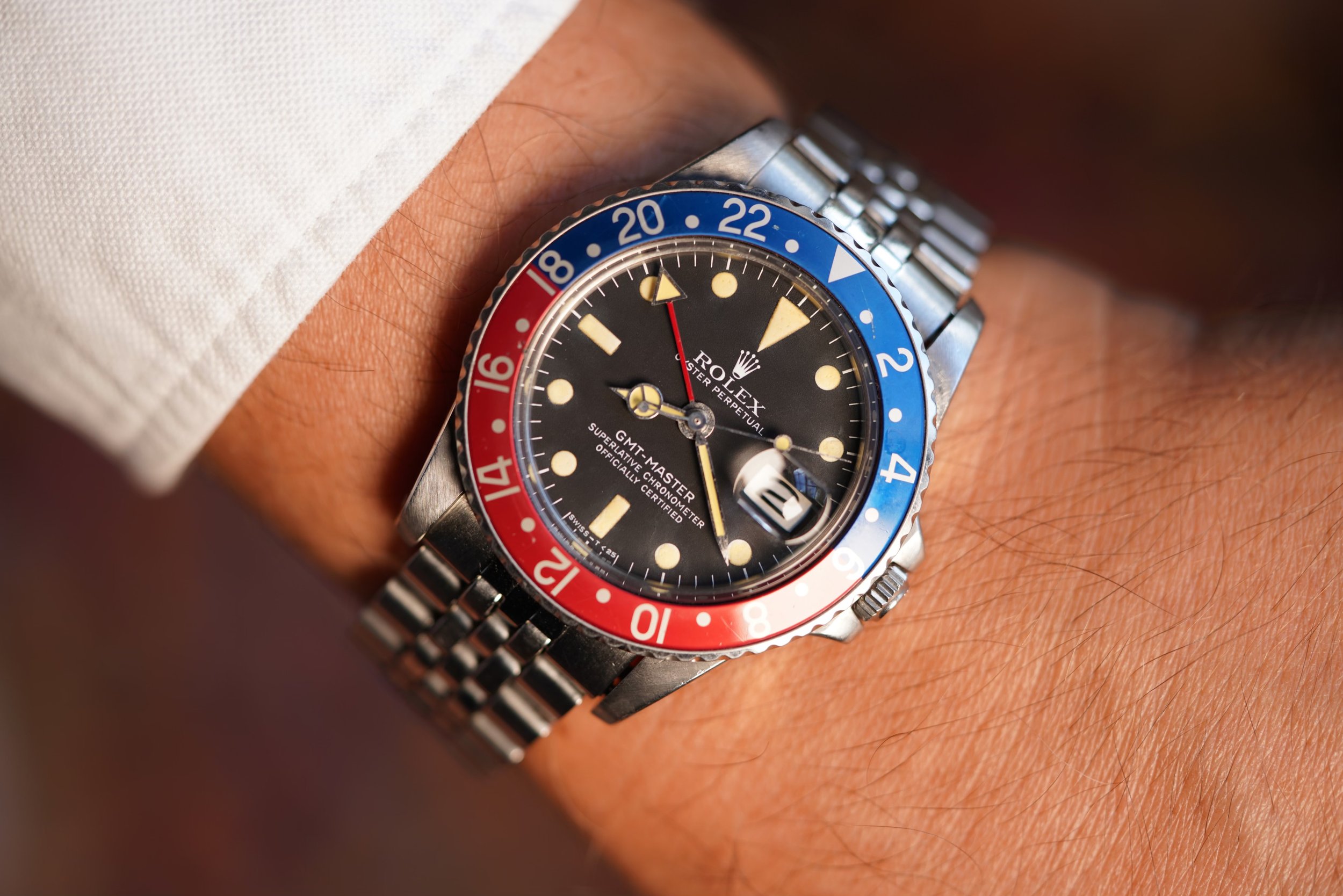Collector's Guide: The Rolex GMT-Master Reference 1675 in Steel
By Charlie Dunne
There’s no other watch like the Rolex GMT-Master reference 1675. 1675s are incomparable to any other watch as the variety of dials and beautiful bezels can be profoundly different across years of production and manner in which they have aged over time. No other Rolex has the distinguishable bezel like a “Pepsi”, and the 1675 has the longest production duration for any Rolex GMT-Master. Rolex introduced the GMT-Master in circa 1959 and the reference remained in production until circa 1980. This two-decade period represents a significant portion of the Rolex’s history and is recognized by most watch collectors as the golden era of vintage-sports watches from any manufacturer.
A very early and unpolished “PCG” GMT-Master reference 1675 with chapter ring dial with a faded 24-hand.
Neue Zürcher Zeitung, Number 898, 24 March 1959
The Rolex factory. Image credit: Neue Zürcher Zeitung, Number 4539, 29 October 1965
The story for the GMT-Master begins when Pan American Airways (Pan Am) and another world-renowned aviation company purportedly commissioned Rolex to create a wristwatch suitable for their pilots: one that allowed them to efficiently tell two time zones simultaneously. Pan Am cites their President Juan Trippe had approached Rolex to create a watch for the airline pilots which resulted in the reference 6542. Throughout the 1950s to 1970s, Pan Am was regarded as a preeminent airline and became one of the largest international air carriers. The company took pride in equipping their pilots with the best amenities - the GMT-Master being one of them! Rolex was thrilled to highlight this relationship with Pan Am in marketing materials. It is akin to the way Rolex highlights their relationships with events such as the PGA Championship, Wimbledon, and the Academy Awards. As you can see later in the article, the manufacturer showcased this relationship within advertisements and catalogs for many years.
‘Travelling Through Time’ produced by Rolex Watch Company and Pan American World Airways in 1966. Source: @niccoloy
Image credit: metroairportnews.com
Image credit: panambrands.com
Image credit: miami.edu
Over the past two years, I became enamored with a number of different 1675s, each one with its own unique look. Many of these examples belonged to collector friends and are worthy of being one-watch collections. Thinking about this reference, I came to realize it is not the historical significance of the watch that made it special to me, but rather the diversity of exceptional reference 1675 examples that I have seen. This excitement for the reference led to me seek out [my mentor and boss] Eric Wind’s assistance in finding [a worthy] one for my personal collection, and subsequently writing a small tribute to this wide-ranging reference that you are reading now!
A late gilt dial Rolex GMT-Master ref 1675 circa 1966.
The Dial
One of the more complex and interesting aspects of the 1675 is the dial variations. These dials are categorized within two genres: “gilt / glossy" and “matte”. The earliest dials are known as “OCC” bearing the text “Officially Certified Chronometer” which can be seen in pre 505,XXX serials. Collectors find gilt dials to be extremely enticing. One can get lost staring into a slick-surfaced gilt dial with warm accents and seeing the gold text and details shine in the light can be intoxicating. My understanding is that these dials were made exclusively by Jean Singer & Cie (the prolific and independently owned dial manufacturer based in La Chaux-de-Fonds). Collectors lean towards gilt GMTs if they have the means to spend a premium on a vintage GMT.
A very early tropical PCG GMT-Master Reference 1675 dating to circa 1960.
Some collectors say they will only buy examples with warm-colored lume, and don’t enjoy the puffy, lighter-colored (“zinc sulfide”) lume found on later gilt dials. I find this to be a bit of a missed opportunity, as some of the most beautiful examples fall into this category (see the example above). In some instances, the lume on these dials is still functional! Speaking with Eric Wind, he detailed “Rolex produced gilt dials for their entire line of watches until circa 1966. I see gilt dials ending around the 1.6M serial.” One of the misnomers I am frequently hearing from dealers is that the luminous material of this period is zinc sulfide, and would then transition to tritium which is shockingly dumb.
OCC Dial. Image credit: 100 Superlative Rolex Watches by John Goldberger
OCC Dial Rolex Advertisement. Source: Ad Patina & Cameron Ross Steiner.
1.19M serial dating to circa 1965.
“Exclamation dial which can be seen in models from circa 1964. Image credit: Hodinkee
In circa 1963, we see a transition from closed to open-chapter ring. In addition, this example features an “Underline” dials which can be seen in examples from circa 63-64 to mark the transition from radium to tritium. Image credit: Hodinkee
Some dial details to factor in when looking into early reference 1675s: In circa 1963, we see a transition from closed to open-chapter ring. The “Exclamation” dials can be seen in models from circa 1962 and are thought to indicate a low level of radium / radiation for the dial. Just after these, we see “Underline” dials from circa 63-64 where the dial and hands exclusively use tritium without any radium. Similar to the Oyster Perpetual reference 1018 models, it appears that shortly after the 1964 case production, Rolex would no longer hyphenate “Oyster-Perpetual” on their dials (although the hyphen is not exclusive on earlier examples). Shortly after the transition to matte dials, we also see examples begin to have a GMT hand that is larger triangle around circa 1967 case production.
Non-hyphenated Oyster Perpetual signature on circa 1965 example.
Dial maker. Image credit: Singer
Jean Singer & Cie factory under reconstruction in 1950. Image credit: Singer
Employment advertisement for OMEGA and Jean Singer & Cie. L'Impartial, 4 April 1966
Employment advertisement for Jean Singer & Cie. L'Impartial, 6 February 1978
Employment advertisement for Jean Singer & Cie. L'Impartial, 4 April 1966
Reference 1675 w/ gilt dial and puffy warm lume.
Matte-dial Rolex GMT-Master 1675. Image credit: James Fisk
Reference 1675s with matte dials would enter the picture in circa 1966, and continue through the remainder of the reference’s production until circa 1980. The matte dials were produced by the dial manufacturers Singer, Beyeler, and Lemrich. These consist of designated dial variants Mk0-Mk6. I quite appreciate a gradient surface with beautiful warm hour markers that lay flat. Compared to the glossy surface, these are often a stark contrast with a gritty black exterior and clean white font. The more modern hour markers with white-gold “surrounds” would be introduced in the successor reference 16750 after the earliest “transitional” matte dials for the reference 16750. Gold and Two-Tone 1675s (technically denoted as the 1675/8 and 1675/3 respectively) had the "nipple dials” where the hour markers resemble their namesakes. Most drawn to the vintage aesthetic tend to lean towards the original unconfined luminous hour markers of the 1675s.
Association of Dial Makers. Journal du Jura 1982
Matte dial reference 1675 dating to circa 1978.
Mk 0.5
Mk I
Mk I
Mk I
Mk I
Mk II
Mk II
Mk III Radial Dial
Mk III Radial Dial (Image credit: Hodinkee).
Mk 4
Marlon Brando’s Rolex GMT-Master ref 1675 with Mk 4 dial (Image credit: Hodinkee).
Mk 5
Mk 5
Mk 5
The Case
The GMT-Master is part of the iconic Oyster case family that established Rolex’s success. Each were hermetically sealed and were water resistant up to 50 meters (approximately 165 feet) [In comparison, the Submariner 5512/5513 with a larger cases/crowns were made water resistant to 200 meters]. To this day, one of the important factors of why vintage-sports Rolex watches are so collectible is the fact they are one of the few vintage watch models that can easily be made water resistant. The reference 1675 would institute crown guards into the GMT-Master model. This case evolution helped protect the crown and stem against unnecessary damage due to impacts. At this period Rolex were accommodating their timepieces for the “professional” clients and environments. Crown guards were beginning to become the standard within sports watches, and this would align with the 1959 introduction of crown guards within the Submariner reference 5512. It could be surmised that Rolex influenced OMEGA to transition to crown guards and the asymmetrical case found for the Speedmaster Professional starting with the reference 105.012 in 1963.
1675 and 6542. Image credit: James Fisk.
Early examples of the ref. 1675 feature pointed crown guards (P.C.G.) which are often described as looking like a parrot's beak.
Although we cannot say for absolute certain, it seems likely the case maker for steel vintage 1675s was Genex S.A. The case manufacturer was closely alligned with The Crown during the emergence of waterproof sports watches. The Genex hallmark, Key (Poinçon de Maître) 12, can be seen within several of the sports models of the era (including gold examples of the reference 1675). The case maker was eventually acquired by Rolex. In a 1984 publication, Rolex Director Harry Borer stated that Genex employed around 1,150 individuals!
Article featuring Rolex Director Harry Borer. Bieler Tagblatt, 10 January 1984
Genex SA employment advertisement for hallmarking specialists. L'Impartial, 7 September 1982
The initial production of the 1675s feature pointed crown guards (PCG) resembling a parrot’s beak and are also known as “Cornino” models by Italian collectors. These early PCG models would evolve to a broader pointed crown guard. These two types of early PCG styles are seen until circa 1963-1964 case production and the rounded crown guards would emerge with case production circa 1964/1965. Within the PCG models, the earliest examples feature a flat surface that extends slightly beyond the bezel before descending at an angle. Oftentimes, these are lost by way of the polishing wheel. Another thing to mention is these bezels have a much thicker knurling in the earliest examples which has a coarse feel and resembles a soda bottle’s cap.
The reference 1675 has a case diameter of 40mm in diameter (excluding the crown guard), measures 47.5mm lug-to-lug, and has a 20mm lug width. Even by today’s standard, these watches wear tremendous on the wrist (whether small or large). For collectors who appreciate a thinner sports watch, the GMT-Master 1675 caters a bit more to this more than a Submariner 5512 or 5513 and is a bit of a contender to the Explorer 1016. Throughout the production, the reference 1675 incorporates the twin-lock crown. As standard within Rolex models, the serial number is between the lugs at 6 o’clock and the reference number is between the 12 o’clock lugs. The case production year can be seen on the interior case back until circa 1972, when Rolex discontinued having the production dates engraved on the inside of case backs.
Rolex GMT-Master reference 1675 w/ Pointed Crown Guards circa 1960 with Gilt Dial Type 1.
Later PCG style with wider gap between the crown guards and crown.
Photograph by Tony Traina
U.S. Patent for the GMT-Master case. Note the crown guards.
One key attribute for collecting reference 1675s is to look for the chamfered or beveled lugs. On unpolished examples, these are an extremely attractive element to the case. For collectors, it is important to note that the earlier examples of the reference 1675 often had wider chamfered edges but by the end of the reference 1675 production the bevels are much narrower. Oftentimes, when vintage GMT-Master watches are recut or laser welded the people doing the work add thicker bevels or narrower bevels due to lack of knowledge and these incorrect chamfers can be quite jarring and incorrect for the era. The beloved bevels are featured in the subsequent references to a lesser extent, but would be sadly removed from the case completely once ceramic bezels entered the picture. It is similar to how the “white gold surrounds” hour markers beginning with the later reference 16750s changed the nature of the GMT-Master forever and made so many of us vintage collectors only want the early “transitional” reference 16750s or 1675s due to the charisma of the luminous material being applied directly to the dial.
Comparable Offerings & Prices
Rolex Non-Luminous Linen Datejust Reference 1601 (2.39M serial dating to circa 1970)
Rolex Zephyr Oyster Perpetual Reference 1008 (0.66M serial dating to circa 1961).
It is interesting to look at the prices of the GMT-Master reference 1675 from a historical perspective. In 1966-1968 the reference 1675 was offered as high as $245-$275. It was among the higher-end prices for stainless steel sports models within the Rolex catalog. The Rolex Datejust would be in the $235 range as well, while the “Zephyr” Oyster Perpetual reference 1008 was more expensive at $300! The comparable Rolex Explorer reference 1016 was around $205-$220. The Submariner 5512 was sold in the United States for around $210 - $235, while the non-chronometer reference 5513 would be sold around $160 - $175. A Daytona reference 6241 (perhaps with a “Paul Newman” dial) could be purchased new in the $210 range! At an even higher premium were the luxurious models. A Day-Date reference 1803 on a leather strap would be $600 and $1,200 on bracelet. This is very interesting context from the modern perspective where vintage Zephyrs and vintage Day-Dates can be purchased for considerably less than a vintage GMT-Master in great condition. The GMT-Master reference 1675 was a superior product from on the performance front and inferior on the status front. All the while, gold and two-tone models were the luxurious offerings and marketed as such. The GMT-Masters and the Submariners were also marketed for the professionals, albeit not to the same level of prestige as a sophisticated Day-Date
Rolex Explorer I Gilt Dial Reference 1016 (1.3M serial dating to circa 1966).
Rolex Submariner “Neat Fonts” Reference 5512 (1.658M serial dating to circa 1967).
Rolex Wide Boy Day-Date Reference 1803 (2.38M serial dating to 1970).
Steel 1675 vs Yellow Gold 1675.
Rolex GMT-Master 1675 on Jubilee in 18K Yellow Gold 3.6M serial.
Rolex Concorde GMT-Master 1675 in 18K Yellow Gold
Bracelets
The bracelets equipped on steel 1675s vary over the course of the production. Most frequently, these were manufactured by Gay Frères, the preeminent bracelet manufacturer. Rolex and Gay Frères were closely aligned over their history, as the majority of Rolex’s catalog was paired on bracelet. Rolex was GF’s most important client and it would lead to the brand’s acquisition of the bracelet maker in 1998.
There are three styles: Oyster (rivet - Swiss or US, folded link, and solid link) and Jubilee (also in a few variations). We often see vintage GMT-Masters offered for sale on bracelets that are not period correct. This incongruous sight can be a bit irritating when the head is paired on a bracelet from 15+ years later and/or for a subsequent reference. This is often seen on “established” vintage marketplaces or dealer websites and is done for A. cost saving, B. ignorance, and/or C. lack of effort. Of course, bracelets were often replaced during service. However, as seen on each of the previously-sold watches featured in this article, an effort was taken in order to make sure the watches are paired on correct bracelets. Having a 1960s gilt GMT-Master reference 1675 on a solid-link Oyster 78360 is just a terrible and sloppy look.
1958 Rolex catalog featuring the 6636 stretch-Rivet bracelet made by Gay Frères for Rolex.
1958 Rolex catalog featuring the 7206 Rivet bracelet made by Gay Frères for Rolex.
The most commonly sold Rivet bracelet on the early GMT-Master reference 1675 examples were the references 7206 (non-stretch) and 6636 (stretch) made by Gay Frères for Rolex with 80 end links. These were sold on Rolex watches from the mid 1950s until circa 1969. We have seen some of the earliest reference 1675s with 64 end links, the predecessor of the 80 end links. These Swiss-made Rivet bracelets feature a center link that is wider than the outside links. While we often see examples of 7206 bracelets with 58 end links on vintage GMT-Masters from the 1960s, it is our opinion that 58 end links were correct for Explorer Is and Datejusts and not born on GMT-Master examples.
A nice vintage Swiss rivet bracelet can be costly if in exceptional condition, up to the $4,000 range for a nice Swiss-made Oyster rivet 7206 or 6636 with 80 end links (and considerably more for earlier versions with the “Big Logo” clasp for the predecessor reference 6542). There are methods of “restoring” or rejuvenating the form of the bracelet by way of replacing the pins between the links and this is generally accepted by collectors, just like driving a vintage car with tires that are worn out is not seen as a positive for vintage car collectors.
American-market bracelets include unsigned Rivet-style bracelets (both stretch and non-stretch versions) with the identifiable hollow rivets with holes in them on the side and center links that are essentially the same size as the outer links. These are understood to have been produced by Cromwell International with a C, fleur-de-lis, and I logo on the inside clasp next to Rolex USA. Collectors often call these “C+I” bracelets with a plus symbol in place of the fleur-de-lis.
These have also been seen with Oyster bracelets made by WAB in England for the English market. These often had links that are similar to the C+I bracelets with a link being made made of three bars of equal size, however the center links were polished. These are quite rare, but don’t really carry much of a premium.
The Oyster rivet bracelet would transition to an Oyster folded link 7836 bracelet with 280 end links in circa 1970 then transitioning to 380 end links shortly thereafter circa 1971/1972. In circa 1976, the transition to solid-link Oyster bracelets for the GMT begins with the reference 78360 bracelet and 580 end links.
C&I Rivet bracelet.
Oyster folded link 7836 bracelet with 380 end links
C&I Rivet bracelet.
Oyster folded link 7836 bracelet with 380 end links
C&I Rivet bracelet.
Oyster folded link 7836 bracelet.
Rolex 78360 bracelet with solid links and 580 end links. Circa 1977
Rolex 78360 bracelet with solid links and 580 end links. Circa 1977
Gay Frères bracelet manufacturer advertisement. Image credit: Europa Star. EUROPE | 1969 | ISSUE #60 | 6/6 | PAGE 207
Gay Frères bracelet manufacturer advertisement. Image credit: Europa Star. TRADE BULLETIN | 1970 | ISSUE #677 | 1/12 | PAGE 11
Rolex USA oval link Jubilee bracelet made by J.B. Champion
For Jubilee bracelets, we see some examples of vintage GMT-Master watches with American-made Jubilee bracelets (made by J.B. Champion in Woodside, New York) with 50 end links that have come from original owner and it seems like they may have been paired on those bracelets in the store at time of purchase or at Rolex USA prior to distribution. These American-made Jubilee bracelets are known as “oval link” bracelets due to the profile of each link looking like an oval. The earliest ones from the 1960s had interior clasps that say J.B. in a triangle, while by the late 1960s they only refer to Rolex and U.S.A. on the inside clasp. These American Jubilee bracelets have considerable weight and heft compared to the Jubilee reference 6251H bracelets made in Switzerland. One interesting fact is that by the late 1950s, J.B. Champion had already produced over 50 million watch bands according to their advertisement in Europa Star.
We also see ads where it seems possible that some left the factory with 6251H bracelets, but it seems 55 end links seem too small for the reference 1675 and were meant for Datejusts.
Starting around the 1980s, we see GMT-Masters with 62510H bracelets (often called D-link bracelets as the profile resembles a “D”) and 450 or 550 end links that no doubt left Switzerland on those bracelets, perhaps as a result of the popularity of the American-made Jubilee bracelets on GMT-Master reference 1675s in the 1970s.
JB Champion bracelet manufacturer advertisement. Image credit: Europa Star. ASIA | 1959 | ISSUE #51 | 1/6 | PAGE 11
JB Champion bracelet manufacturer advertisement. Image credit: Europa Star. ASIA | 1957 | ISSUE #40 | 2/6 | PAGE 169
Movements in The GMT-Master 1675
Calibre 1535 (1959) & 1565 (1959-1964)
Introduced in 1959, the calibre 1565 is an important automatic movement with calendar and a 24-hour GMT complication. These movements were produced by Rolex. Each movement was chronometer certified which involved testing the movement in various positions and temperatures to specification of −4 to +5 seconds per day. The calibre operates at 18,000 VBH. It features a 44-hour power reserve. These movements are commonly signed 1560. These were not ornately decorated, nor are considered “beautiful” movements. They are strictly performance oriented with great reliability.
Note: Certain “OCC” reference 1675s have been seen with the calibre 1535, while most examples feature the calibre 1565.
Calibre 1575 (1965-1980)
The calibre 1575 is the successor calibre to the 1565. It was introduced in 1965 and features a 48-hour power reserve. The calibre 1575 operates at 19,800 VBH and like the 1565 is a chronometer certified movement. …These can be signed 1570. It would also used within the Explorer II reference 1655. In circa 1971, Rolex would modify the calibre to incorporate a hacking function. Both the calibre 1565 and the calibre 1575 are highly-reliable automatic movements. These were not ornately decorated, nor are considered “beautiful” movements that represent the performance-oriented watchmaking Rolex is known for.
“Does it have box and papers?”. A full set reference 1675 from 1961.
1968 chronometer papers for a 1.72M case serial GMT-Master 1675 from circa 1967.
Circa 1967 Rolex GMT-Master reference 1675 w/ papers.
GMT-Master 1675 hang tag circa 1970
Catalogs/Marketing Material
The promotional material for the reference 1675 is certainly romantic. The watch was marketed for “ships’ captains, members of the armed forces and international business men” and just about “everybody to whom the knowledge of local time only is insufficient.” The earliest coverage (of the reference 6542) in Time Magazine highlights the “eleven new patents [for this] unique precision masterpiece”. Again, the Pan Am relationship would be emphasized at length while proving the point that the GMT-Master was the “finest timepiece available to the flight navigator”. The section below is dedicated to a wide range of marketing and primary-source material featuring the reference 1675.
Image credit: static.piguet.com
One particularly cool and rare advertisement features Arnold Palmer on the runway with his personal plane. The advertisement dates to the circa 1965 for the Japanese market featuring a Rolex GMT-Master reference 1675 with Pointed Crown Guards. This advertisement is quite rare and I have only seen it in an offering of personal effects and Rolex documents of René-Paul Jeanneret, the director of Rolex during the era.
Image credit: USGA
René-Paul Jeanneret. Image credit: Antiquorum.
Image credit: Ad Patina
Speaking with collector and founder of Ad Patina Nick Federowicz, he would provide a great range of advertisements and insight to the important Rolex GMT-Master reference 1675 and how it was marketed.
Image credit: Ad Patina
“The Grail-worthy GMT Master Reference 1675, in steel, was in production across the golden era of Rolex design - from around 1959 well into the late 1970s. Coinciding this illustrious history of the Ref. 1675 were print advertisements of equal beauty and timelessness. I find that the magazine ads - and catalogs - from the Ref. 1675 era interestingly mirror the uniquenesses and characteristics of the actual watches. For example, in the early and mid-1960s, you'll find advertisements designed to market the GMT Master specifically, featuring unique imagery and copy highlighting the model's practicality and functionality. This fact parallels the actual GMT Master watches of the day, which we know have their own special qualities, even within the GMT line. The minute details we love in the earliest Ref. 1675s, like "Exclamation" and "Underline" dials, and pointed crown guards, just to name a few, are inherent in their own form in the ads of the time period, making the early marketing material as fascinating, rich, and collectible as the watches themselves. Such as, I've only come across 1 magazine ad from the 1960s showing a "gilt / glossy" dial, steel Ref. 1675 in color! The majority of 1960s GMT ads are in black and white.
Image credit: Ad Patina
Image credit: Ad Patina
As globetrotting via airplane - and wearing the GMT Master - became more prevalent in society, so too did Rolex print advertisements become more prolific across magazine titles. Around the time the "latest technology" matte dial update was released, a version of the GMT Master that would be in production for approximately 15 years, a new campaign for Rolex took flight. The classic, "If you were..." design language, with its signature black background and white Helvetica typeface touched down in magazine pages, ushering in a new marketing strategy... That strategy would be to have a more uniform look to the advertisements - a template of sorts - and essentially just adjusting the copy and imagery to fit the model being promoted (one-off style ads published pre-1967 are no longer the norm). Of course, GMT Master ads from late 1968 through early 1970 featured the famous Concorde - a smart and natural association you'd expect from a business savvy brand like Rolex. Naturally, the handful of ads pairing the supersonic, jet-setting plane to the ultimate travel watch are the most well-known and most-popular. These ads not only immortalize a legendary Rolex model, but also, represent a legendary ad campaign.
In the 1970s, when the look of Rolex ads transitioned to a long-form layout, marketing the GMT Master also evolved to show a more expansive use for the model, such as being a highly-capable companion for expeditions on land and sea as well. The final ads to feature the Ref. 1675 are as recognizable - and iconic - as the "If you were..." format. Compared to modern ads, often with no copy, it's hard to miss these vintage gems laden with paragraphs. While Rolex has always used notable individuals in their print advertisements, it's these ads from the 1970s when Rolex doubles down on using adventurers and other professionals at the top of their field as brand ambassadors.
There's no doubt in my mind that the sheer abundance of GMT Master ads created through the 1970s were highly-effective in selling Rolex watches. I like to think the magazine ads played a vital role influencing purchases and inspired wearing these great watches, which ultimately is the reason they've developed the incredible patina we love and why we appreciate and collect.”
Image credit: Ad Patina
Image credit: Ad Patina
Circa 1964
I Want A Good Watch. Circa 1961.
OCC Dial Rolex Advertisement. Source: Ad Patina & Cameron Ross Steiner.
A 1962 Rolex catalog featuring a reference 1675 with pointed crown guards and with a WAB bracelet with a polished center link, which makes sense as this was for the English market. It shows a price of approximately 73 pounds for the watch.
I Want A Good Watch. Circa 1964
1966 Rolex catalog. Image credit: rolexforums.com Styles Bitchley
1963 I Want A Good Watch catalog featuring PCG 1675.
1968 GMT 1675 advertisement for Japan.
Key features of the watch highlighted were the “Revolutionary red 24-hour hand and revolving rim calibrated into 24 hours, simultaneous indication of local time for any two time-zones.” Of course the revolutionary Rolex Oyster case which was guaranteed to be waterproof and the “Twinlock double-safety winding crown”. Of course included is the proprietary Perpetual self-winding movement! One ingenious visual component on the catalogs is the world map, which serves as a reference to visually understand the dual-time component of the watch.
An interesting anecdote about vintage GMTs is that these watches also serve as a compass! This usually comes to the realization after pointing out that in the catalogs there is a mention of this feature. If you are in the Northern hemisphere, when you point your hour hand towards the direction of the sun, you will see a direct line path to North via the GMT hand. When you are in the Southern Hemisphere, the GMT hand will point South.
“American Rolex catalogue 1966”“American Rolex catalogue 1966” Image credit: Stefano Mazzariol
1960s GTM-Master catalog. Image credit: @amanico WatchProSite
1960s GTM-Master catalog. Image credit: @amanico WatchProSite
1960s GTM-Master catalog. Image credit: @amanico WatchProSite
Image credit: gmtmaster1675.com
1968.
Canadian advertisement circa 1969.
Rolex GMT-Master reference 1675 catalog circa 1968.
Bucherer Rolex catalog featuring a Rolex Paul Newman Daytona, a GMT-Master 1675 and a “Meters First” Submariner 1680.
Image credit: hifi-archiv.info
Image credit: hifi-archiv.info
1969 catalog. Image credit: On The Dash
Circa 1970
Revue économique franco-suisse, Volume 50 (1970)
1971 catalog.
Circa 1972
1970s
Advertisements
Below is a wide variery of advertisements from the 1960s to 1980 featuring the Rolex GMT-Master reference 1675. They are exclusive to the U.S. and Switzerland advertisements. Quite interestingly, the date is almost always set to 28.
Neue Zürcher Zeitung, Number 1145, 28 March 1961
Rolex “PCG” GMT-Master reference 1675. Flying Magazine May 1963.
The Sydney Morning Herald 1966.
Image credit: WatchProSite
The Miami Herald 1973
Image credit: RolexMagazine
Image credit: Ad Patina
Image credit: Ad Patina
Image credit: Ad Patina
Manchester Evening News 1978
The News and Observer 1977
Honolulu Star Bulletin 1976
hifi-archiv.info/ rolex advertisement 1972.
The Montreal Star 1973
Reno Gazette 1979
1966 GMT-Master 1675 advertisement.
Neue Zürcher Zeitung, Number 750, 4 December 1968
Neue Zürcher Zeitung, Number 575, 10 December 1970
The News and Observer 1980.
The Los Angeles Times 1966
The National Post 1966
1968 Advertisement
L'Impartial, 25 October 1974
Neue Zürcher Zeitung, Number 213, 13 September 1980
The GMT-Master was the thoroughgoing timepiece for its era. While the predecessor reference laid the groundwork in providing professionals with the ability to easily reference their home time while traveling, the mass-produced reference 1675 was a impactful by democratizing this tool watch in retailers throughout the world. Rolex founder, Hans Wilsdorf would sadly never see the success of the 1675, as he would pass one year into the model’s production. Yet it would go one to become one of the most prolific offerings from any manufacturer. The reference is far from rare when compared to earlier iterations of the GMT-Master. However, finding examples with great provenance, as well as in fantastic and original condition is not so simple.
Bezels
One of the most enchanting features of the reference 1675 is the colorful bezel insert. Each 1675 has a bidirectional rotating bezel. When considering Submariners or Sea-Dwellers, the aesthetic is much more constrained with each bezel insert beginning its life in black (with exception to the full black bezel inserts in GMTs thought to be seen as early as the 169s). By comparison, GMT bezel inserts would come out of the factory in a range of colors. These bezel inserts are made from anodized aluminum and Rolex made the switch from the original bakelite bezels on the reference 6542 due to the famous claim from an American that the radioactive materials in the bezel caused cancer and health problems for his family and him.
In the gilt era of circa 1960 through 1966, through early matte dials up the mate late 1960s, the triangles at 12 o’clock on the bezel inserts are slightly smaller than on later GMT-Master inserts and show blue color above them. The later examples have the top of the triangle touching the top edge of the bezel insert. The gilt (and early matte) 1675 inserts examples often feature an auburn tone of reddish-orange. The red-orange or blue can fade and wear, making each insert unique. Ironically, it is often the case where one of the two colors maintains a strong coating.
2.009M serial reference 1675 dating to circa 1969.
The quintessential “Pepsi” with the classic blue and red bezel insert is the most consistent variant one can expect to find, and can be seen across much of the production run. It is an easy color combination to love and it is quite astounding to compare the different shades of blues vs reds and numerals.
Pepsi GMT-Master ref. 1675 circa 1977-1978 (5.17M Serial)
Radial Dial GMT-Master 1675. 5.07M Serial
Radial Dial GMT-Master reference 1675 circa 1978.
Marlon Brando's Rolex GMT-Master From 'Apocalypse Now'. Image credit: Hodinkee
Interesting to note, many collectors are driven to purchase a GMT by amazing colors of the insert. Yet, the most expensive Rolex GMT-Master reference 1675 sold publicly was absent of a bezel all together! Marlon Brando’s famous GMT worn in the film Apocalypse Now initially for $1.95M in 2019 and then for over $5 million dollars with buyers premium in 2023.
Marlon Brando's Rolex GMT-Master From 'Apocalypse Now'. Image credit: Hodinkee
Rolex GMT-Master “Matte Dial MK II” reference 1675 circa 1972.
Aluminum would remain in use until Cerachrom inserts became the standard in circa 2007. The tendency to show signs of wear or fading can be quite charming for collectors, and this is somewhat of an appealing factor for the older examples versus watches today. One can quite literally recognize their own watch amongst several other reference 1675s by the unmistakable appearance of their bezel. This is not quite the same with the modern GMTs, as they are created with the strict intention of the Cerachrom bezels holding up to the elements and not changing. It makes sense for the majority of modern Rolex consumers to feel comfortable that their watches maintain uniformity over the course of their lifetime. From a personal perspective, I have a hard time imagining they find as much joy in the exclusive nature of a vintage bezel insert! Above are two 1675s with inverse-like bezels. One retains an intense orange bezel with a blue which has almost completely faded. The other features a strong blue, with an almost completely faded red!
“Character is Beautiful”
An unpolished Rolex GMT-Master with “Mark 0.5” dial from 1967 - on with the original crystal and below with a TrueDome D38.
Per the crystals, the 1675 will have a Tropic 127 with cyclops. However, Wind also mentions some collectors use a Tropic 38 for a more domed look, or an alternative TrueDome D38 for better aesthetic and protective purposes.
1.72M Serial circa 1967.
One particular area of interest in collecting surrounds the GMT-Master with the “fuchsia” or “Pink Panther” inserts. These bezel inserts were produced within models with the 1.8M-1.9M serial range (1968-1969). These can be extremely exciting to see in person, as the bezel has a powerful presence and this vibrant color is never found within other vintage Rolex models. We sometimes see examples in this range with tropical brown dials, which are extremely appealing and desirable for collectors!
Fuchsia GMT-Master 1675 featuring a 1.82M serial number dating to circa 1968.
1.8M serial circa 1967.
Mark 1 Rolex GMT-Master reference 1675 dating to circa 1968-1969
During the early 1970s, we begin to see the bezel insert’s numerals become more bold. The nickname for this style is “Fat Font”. Coupled by a particularly vibrant insert these can be very exciting to see in person. Even those with very poor eyesight will have no issues in using the fat font bezel.
Examples featuring the “petrol blue” inserts are extremely attractive also. Oftentimes, the blue will hold up against the aging process with more signs of fading in the red. These bezels are present in the late 1960s and into the early 1970s.
An unpolished Rolex GMT-Master Reference 1675 from 1972 with 7836 folded Oyster bracelet
An unpolished Rolex GMT-Master Reference 1675 from 1972 with warmer patina paired on 7836 folded Oyster bracelet.
Another unpolished Rolex GMT-Master Reference 1675 from 1972 with warmer patina paired on 7836 folded Oyster bracelet.
Rolex GMT-Master reference 1675 with “Blueberry” insert.
Along with the all-black aluminum inserts, there are all-blue inserts commonly referred to as the “Blueberry” inserts. These inserts are often controversial as there are certainly fake blue-bezel inserts offered on the market. As Jon Bues and Eric Wind wrote in Reference Points regarding the Blueberry insert:
"These watches hail from the '70s and are thought to coincide more or less with Rolex's introduction of the all-black aluminum insert, perhaps as a trial of a single-color bezel before Rolex settled on black as another option for people besides the Pepsi insert.
It should be stated up front that this bezel insert is a controversial part, and the collecting community remains divided as to whether these all-blue inserts were ever even made by Rolex. Bezels aren't signed like dials, cases, movements, and bracelets, making them easier parts to fake, and many of the examples one is likely to find online are replica parts. What's not debatable is that the Blueberry GMT-Master is among the most desirable watches of the ref. 1675s. Collectors that believe in the veracity of these bezel inserts as being made by Rolex generally settle on the fact they should be on watches in the 5 million serial range dating to the late 1970s. And watches in that 5 million case serial range include Mark 2, Mark 3, Mark 4, and Mark 5 dials, so you see these all-blue bezels on a variety of dial configurations.
For those who believe in them, it's generally understood that original watches with these blue inserts were not offered at retail, but that the all-blue bezel insert was a test bezel offered to Rolex Service Centers and select retailers to offer to clients. Some have claimed they were reserved for military orders in the Middle East, as some United Arab Emirates (UAE) dial GMT-Masters have been seen and even sold at public auction with the Blueberry inserts, but it is certainly possible the bezel inserts were added to those watches.”
All black inserts are seen in the late 1970s. However, they are not typically desirable for collectors and are also very hard for dealers to sell.
Rolex GMT-Master 1675 w/ "Mark 5" dial from circa 1978.
From the mid-1970s to the end of the production, the classic blue and red bezel insert remains quite consistent. The watches take on a bit more heft as a result of the solid links which feel a bit more substantial on the wrist. These late 1970s GMT-Masters are quite a nice area to start collecting, as they can often be in good condition and can be a comfortable passage into vintage for a person accustomed to the sizes and weights of modern Rolex watches.
Rolex Mark 4” dial GMT-Master Reference 1675 (5.34M serial)
A very late Reference 1675
Rolex Mark 5 dial GMT-Master Reference 1675 (5.3M serial)
Rolex Pepsi GMT-Master ref. 1675 5.8M serial from circa 1979.
A very late Rolex Pepsi GMT-Master 1675 5.8M serial from circa 1979.
I believe that every vintage-watch collector can fall in love with the Rolex GMT-Master reference 1675, despite it being such an obvious watch! The model is not simply an iconic Rolex, but it’s one of the most recognized and respected watches of all time. Prior to starting my career at Wind Vintage, I recall visiting Eric Wind to learn about vintage watches. We met at The Honor Bar in Palm Beach where he showed me his personal gilt GMT-Master, which was a recent anniversary gift from his wife Christine. It was at this moment I became a Rolex guy. Since then, I have been amazed at the quality and unique attributes seen within Rolex watches created over the past century and became a forever fanboy of the Crown.
While this article does not outshine Wind’s and Jon Bues’ ‘Reference Points: Understanding The Rolex GMT-Master' video/article on HODINKEE, I hope this article will serve as an inspiring resource and interesting read for those from beginners first learning about watches to experienced collectors who have owned 1675s for decades.
Acknowledgements: A special thanks to Eric Wind for providing an exhaustive amount of assistance in both the editing and research for this article. Special thanks to Christine Wind for the direction and encouragement to pursue the 1675. “It’s a game changer!” Special thanks to collectors and clients of Wind Vintage for sharing their watches and enthusiasm.
If you are interested in selling your vintage GMT-Master reference 1675 or having Wind Vintage source an exceptional example for your personal collection, please reach out via the form above or email us at info@windvintage.com!





